Paul van Yperen's Blog, page 296
September 14, 2017
Mina
Italian singer Mina (1940) dominated the Italian charts for fifteen years and reached an unsurpassed level of popularity in Italy. The ‘Queen of Screamers’ was a staple of Musicarellos, the popular Italian musical comedies of the early 1960s, and Italian television variety shows. During five decades, she had more than 70 singles in the Italian charts.
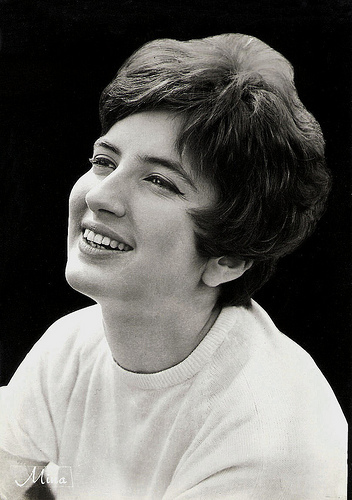
Italian postcard by Rotalfoto, Milano, no. 867.
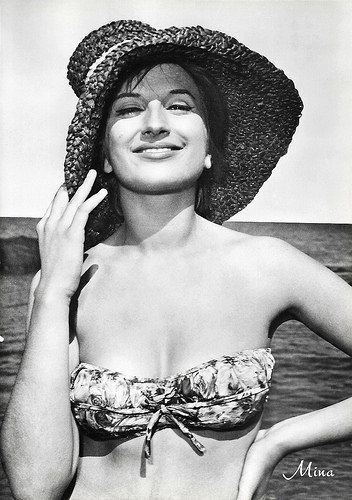
Italian postcard by Rotalfoto, Milano, no. 959.
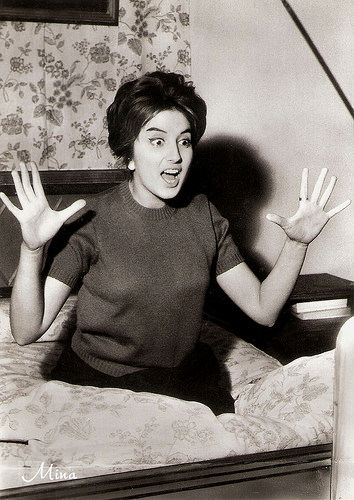
Italian postcard by Rotalfoto, Milano, no. 974.
The Rock and Roll Wave
Mina was born as Anna Maria Mazzini into a working class family in Busto Arsizio, Lombardy in 1940. After finishing secondary school in Cremona, she attended college where she majored in accounting.
She was caught up in the rock and roll wave sweeping across Italy in 1958. Mina listened to American rock and roll and jazz records, and was a frequent visitor of the Derby, the Santa Tecla and the Taverna Messicana clubs of Milan, known for promoting rock and roll.
She started a musical career with the backing of the band Happy Boys. Her repertoire included clumsy imitations of British and American rock and jazz songs, while her extra-loud and syncopated version of the song Nessuno (Nobody) showcased her excellent sense of rhythm. She soon signed with Davide Matalon, owner of the small record company Italdisc.
She introduced her stage name Mina with her first single, Non partir/Malattia. Her performance at the Sei giorni della canzone festival of Milan was described by the La Notte newspaper as the ‘birth of a star’. In 1959, Mina's TV appearances were the first for a female rock and roll singer in Italy and they were a revelation. Her loud syncopated singing earned her the nickname ‘Queen of Screamers’. The public also labelled her the ‘Tiger of Cremona' for shaking her head, hands, and hips wildly to the rhythm.
Her first Italian #1 hit was the surf pop Tintarella di luna (Moon Tan) in September 1959. It was performed in her first Musicarello, Juke box - Urli d'amore/Juke Box - Howls of Love (Mauro Morassi, 1959) with Karin Baal .
In the following year she was seen in the films I Teddy Boys della canzone/The Teddy Boys of Music (Domenico Paolella, 1960), Urlatori alla sbarra/Howling to the bar (Lucio Fulci, 1960) opposite Adriano Celentano , Madri pericolose/Dangerous mothers (Domenico Paolella, 1960) with Ave Ninchi, and Mina... fuori la guardia/Mina... Watch Out! (Armando W. Tamburella, 1961).
In his review of I Teddy Boys della canzone, Tod Kimmell (The Willing Mind) writes at IMDb : “There has never been a film before or since like I Teddy Boys della canzone. Mainly, and blessedly, a vehicle for the incomparable Mina.(...) The big finale field party is almost impossible to watch, and certainly impossible to NOT watch. There are so many disparate sounds and beats fighting for attention, it’s like having delirium tremens... yet incredibly satisfying. I promise that if I ever, EVER, find a copy of this on 16mm, I will show it all over the country, outdoors, for free. Seeing it is a life altering experience that needs to be shared!”.
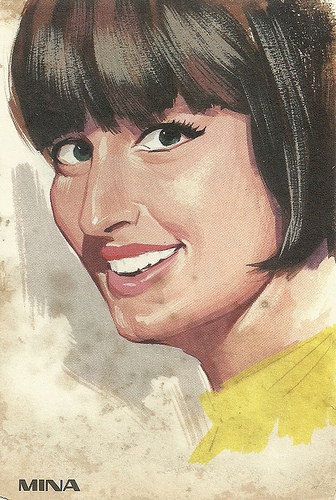
Italian postcard by E.N.P., Roma.
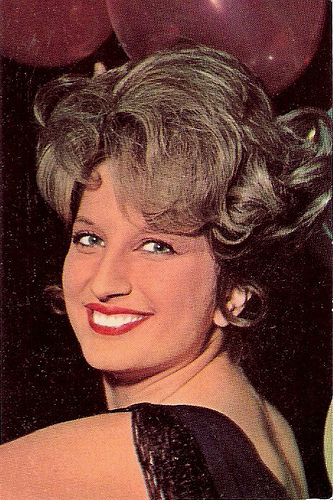
Small collector's card, no. 49.
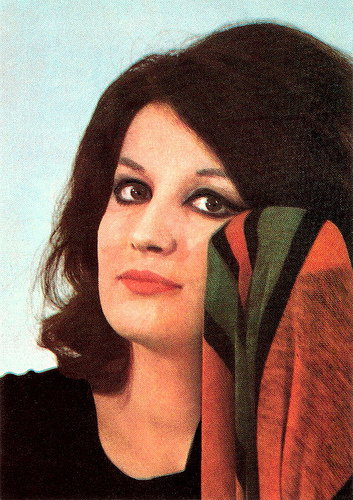
Italian postcard. Photo: RIFI.
#1 in Japan
Mina introduced a more refined sensual manner of singing in 1960 when she sang Gino Paoli's ballad Il cielo in una stanza (The Sky in a Room). The American version of the song, This World We Love In, charted on the Billboard Hot 100 in 1961. Performances of the song were included in the Musicarellos Io bacio... tu baci/I Kiss... You Kiss (Piero Vivarelli, 1961) opposite Umberto Orsini, and Appuntamento a Ischia/Rendezvous in Ischia (Mario Mattoli, 1962) with Antonella Lualdi .
After turning to light pop tunes, she also scored in other countries. The presentation of her German single Heißer Sand (Hot Sand, 1962) on Peter Kraus 's TV show caused a boom of 40,000 record sales in ten days in Germany. The record went to #1 and spent over half a year on the German charts. Mina had six more singles on the German charts in the next two years.
With her single Suna ni kieta namida (Tears Disappear in the Sand), she also had a #1 in Japan and earned the title of the best international artist there.
Her films such as Canzoni nel mondo/Songs of the World (Vittorio Sala, 1963) with Gilbert Bécaud , and Per amore... per magia.../For Love... for Magic (Ducio Tessari, 1967) with Gianni Morandi were also shown abroad.
Her song L'eclisse twist was used on the soundtrack of Michelangelo Antonioni's classic film L'eclisse/The Eclypse (1962) starring Monica Vitti and Alain Delon .
In 1963, Mina was banned by the RAI, the Italian public broadcasting service, because she would not cover up her love affair (and pregnancy) with actor Corrado Pani. He was already married although separated from his wife. Their son, Massimiliano Pani, was born in 1963. In Italy divorce was illegal and single motherhood was considered shameful, so her behaviour certainly did not accord with the dominant Catholic and bourgeois morals.
Despite the ban, Mina's record sales were unaffected and due to public demand, the ban was ended in 1964. Later, the RAI tried to continue to prohibit her songs, which were forthright in dealing with subjects such as religion, smoking and sex. Mina's cool act combined sex appeal with public smoking, dyed blond hair, and heavy use of eye make-up to create a ‘bad girl’ image.
Her main themes are anguished love stories performed in high dramatic tones. She was known for her three-octave vocal range, the agility of her soprano voice, and for her image as an emancipated, independent woman. Her affair with Corrado Pani ended at the end of 1964.
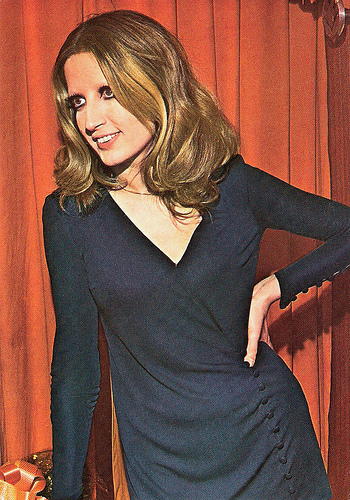
Italian postcard by Grafiche Biondetti (GB), Verona, no. 54.
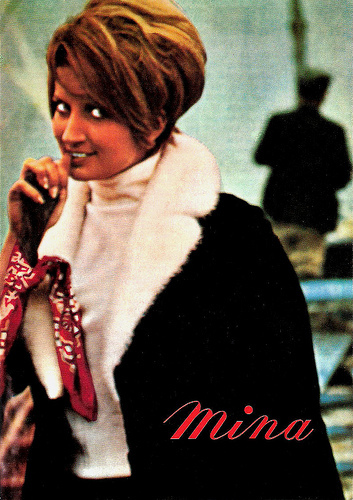
Italian postcard by Silvercart, Milano (Milan), no. 546/1.
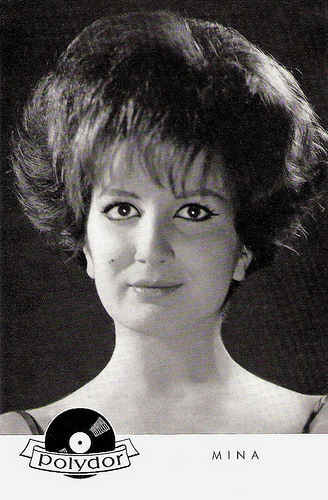
German promotion card by WS-Druck, Wanne-Eickel. Photo: Polydor.
Distinctive Timbre and Great Power
In the mid 1960s Mina became a staple of such Italian television variety shows as La fiera dei sogni and Il macchiettario. She combined classic Italian pop with elements of blues, R&B and soul music during the late 1960s, especially when she worked in collaboration with composer Lucio Battisti.
Top Italian songwriters created material with large vocal ranges and unusual chord progressions to showcase her singing skills, particularly Brava (Brave, 1965) a rhythmic jazz number specially written by Bruno Canfora and the pseudo-serial Se telefonando (If Over the Phone, 1966) by Ennio Morricone. The latter song was covered by several performers abroad.
Her scatting performance of Spirale Waltz (1965) became the theme song for the Sci-Fi thriller La Decima Vittima/The 10th Victim (Elio Petri, 1965) starring Marcello Mastroianni .
Mina's easy listening duet with Alberto Lupo, Parole parole (Words words, 1972), was turned into a worldwide hit by Dalida and Alain Delon in 1974.
Mina's songs were used in the soundtracks for such major films as Matador (Pedro Amodovar, 1986) and Goodfellas (Martin Scorsese, 1990). Mina's voice has a distinctive timbre and great power. In live performances, she combined several modern styles with traditional Italian melodies and swing music, which made her one of the most versatile pop singer in Italian music.
Till the mid-1970s she stayed a dominant figure in the Italian pop music. Mina gave up public appearances in 1978 but she continued to release popular albums on a yearly basis with her son Massimiliano Pani as the producer. Between 1972 and 1995, she published a double album each year. 77 of Mina’s albums and 71 of her singles reached the Italian charts.
The duet album Mina Celentano, recorded with Adriano Celentano , was the biggest-selling album of 1998 in Italy. After releasing new footage of her recording sessions, Mina's singles started to chart in Italy again. The track Succhiando l'uva (2002), written for her by Zucchero, peaked at #3 on the chart. Mina's cover of Don't call me baby (Can't take my eyes off you) (2003) reached #4 in Italy, and the single Alibi (2007) reached #6. The triple CD The Platinum Collection (2004) reached #1 on the Italian charts. So did Olio (1999), Veleno (2002), Bula Bula (2005) and Todavía (2007).
Mina had affairs with the actors Walter Chiari and Gian Maria Volonté. She had a relationship for three years with the composer Augusto Martelli. In 1970 she married Virgilio Crocco, a journalist for Il Messaggero. Their daughter Benedetta Mazzini was born in 1971. In 1973, Virgilio Crocco was killed by a car accident. In 1965, her brother Alfredo Mazzini had also tragically died in a car accident.
Mina became engaged to her current husband, Swiss cardiologist Eugenio Quaini, in 1981. She obtained Swiss citizenship in 1989 and they were married in 2006. In 2001, president Carlo Azeglio Ciampi presented her with the Second Class of the Italian Order of Merit. In recent years, Mina has been writing a weekly column on the front page of La Stampa and a page in the Italian edition of the magazine Vanity Fair where she answers fan letters.
Mina - with I Solitari - sings Tintarella di luna in Juke box - Urli d'amore//Juke Box - Howls of Love (Mauro Morassi, 1959). Source: Miloš 02 (YouTube).
Leader of L'eclisse/The Eclypse (Michelangelo Antonioni, 1962). Source: Eliecer Gaspar (YouTube).
Mina sings Coriandoli. Source: Swing 52a (YouTube).
Mina sings Se telefonando. Source: Mina Mazzini Official (YouTube).
Sources: Mina (Official Site), Wikipedia, and .

Italian postcard by Rotalfoto, Milano, no. 867.

Italian postcard by Rotalfoto, Milano, no. 959.

Italian postcard by Rotalfoto, Milano, no. 974.
The Rock and Roll Wave
Mina was born as Anna Maria Mazzini into a working class family in Busto Arsizio, Lombardy in 1940. After finishing secondary school in Cremona, she attended college where she majored in accounting.
She was caught up in the rock and roll wave sweeping across Italy in 1958. Mina listened to American rock and roll and jazz records, and was a frequent visitor of the Derby, the Santa Tecla and the Taverna Messicana clubs of Milan, known for promoting rock and roll.
She started a musical career with the backing of the band Happy Boys. Her repertoire included clumsy imitations of British and American rock and jazz songs, while her extra-loud and syncopated version of the song Nessuno (Nobody) showcased her excellent sense of rhythm. She soon signed with Davide Matalon, owner of the small record company Italdisc.
She introduced her stage name Mina with her first single, Non partir/Malattia. Her performance at the Sei giorni della canzone festival of Milan was described by the La Notte newspaper as the ‘birth of a star’. In 1959, Mina's TV appearances were the first for a female rock and roll singer in Italy and they were a revelation. Her loud syncopated singing earned her the nickname ‘Queen of Screamers’. The public also labelled her the ‘Tiger of Cremona' for shaking her head, hands, and hips wildly to the rhythm.
Her first Italian #1 hit was the surf pop Tintarella di luna (Moon Tan) in September 1959. It was performed in her first Musicarello, Juke box - Urli d'amore/Juke Box - Howls of Love (Mauro Morassi, 1959) with Karin Baal .
In the following year she was seen in the films I Teddy Boys della canzone/The Teddy Boys of Music (Domenico Paolella, 1960), Urlatori alla sbarra/Howling to the bar (Lucio Fulci, 1960) opposite Adriano Celentano , Madri pericolose/Dangerous mothers (Domenico Paolella, 1960) with Ave Ninchi, and Mina... fuori la guardia/Mina... Watch Out! (Armando W. Tamburella, 1961).
In his review of I Teddy Boys della canzone, Tod Kimmell (The Willing Mind) writes at IMDb : “There has never been a film before or since like I Teddy Boys della canzone. Mainly, and blessedly, a vehicle for the incomparable Mina.(...) The big finale field party is almost impossible to watch, and certainly impossible to NOT watch. There are so many disparate sounds and beats fighting for attention, it’s like having delirium tremens... yet incredibly satisfying. I promise that if I ever, EVER, find a copy of this on 16mm, I will show it all over the country, outdoors, for free. Seeing it is a life altering experience that needs to be shared!”.

Italian postcard by E.N.P., Roma.

Small collector's card, no. 49.

Italian postcard. Photo: RIFI.
#1 in Japan
Mina introduced a more refined sensual manner of singing in 1960 when she sang Gino Paoli's ballad Il cielo in una stanza (The Sky in a Room). The American version of the song, This World We Love In, charted on the Billboard Hot 100 in 1961. Performances of the song were included in the Musicarellos Io bacio... tu baci/I Kiss... You Kiss (Piero Vivarelli, 1961) opposite Umberto Orsini, and Appuntamento a Ischia/Rendezvous in Ischia (Mario Mattoli, 1962) with Antonella Lualdi .
After turning to light pop tunes, she also scored in other countries. The presentation of her German single Heißer Sand (Hot Sand, 1962) on Peter Kraus 's TV show caused a boom of 40,000 record sales in ten days in Germany. The record went to #1 and spent over half a year on the German charts. Mina had six more singles on the German charts in the next two years.
With her single Suna ni kieta namida (Tears Disappear in the Sand), she also had a #1 in Japan and earned the title of the best international artist there.
Her films such as Canzoni nel mondo/Songs of the World (Vittorio Sala, 1963) with Gilbert Bécaud , and Per amore... per magia.../For Love... for Magic (Ducio Tessari, 1967) with Gianni Morandi were also shown abroad.
Her song L'eclisse twist was used on the soundtrack of Michelangelo Antonioni's classic film L'eclisse/The Eclypse (1962) starring Monica Vitti and Alain Delon .
In 1963, Mina was banned by the RAI, the Italian public broadcasting service, because she would not cover up her love affair (and pregnancy) with actor Corrado Pani. He was already married although separated from his wife. Their son, Massimiliano Pani, was born in 1963. In Italy divorce was illegal and single motherhood was considered shameful, so her behaviour certainly did not accord with the dominant Catholic and bourgeois morals.
Despite the ban, Mina's record sales were unaffected and due to public demand, the ban was ended in 1964. Later, the RAI tried to continue to prohibit her songs, which were forthright in dealing with subjects such as religion, smoking and sex. Mina's cool act combined sex appeal with public smoking, dyed blond hair, and heavy use of eye make-up to create a ‘bad girl’ image.
Her main themes are anguished love stories performed in high dramatic tones. She was known for her three-octave vocal range, the agility of her soprano voice, and for her image as an emancipated, independent woman. Her affair with Corrado Pani ended at the end of 1964.

Italian postcard by Grafiche Biondetti (GB), Verona, no. 54.

Italian postcard by Silvercart, Milano (Milan), no. 546/1.

German promotion card by WS-Druck, Wanne-Eickel. Photo: Polydor.
Distinctive Timbre and Great Power
In the mid 1960s Mina became a staple of such Italian television variety shows as La fiera dei sogni and Il macchiettario. She combined classic Italian pop with elements of blues, R&B and soul music during the late 1960s, especially when she worked in collaboration with composer Lucio Battisti.
Top Italian songwriters created material with large vocal ranges and unusual chord progressions to showcase her singing skills, particularly Brava (Brave, 1965) a rhythmic jazz number specially written by Bruno Canfora and the pseudo-serial Se telefonando (If Over the Phone, 1966) by Ennio Morricone. The latter song was covered by several performers abroad.
Her scatting performance of Spirale Waltz (1965) became the theme song for the Sci-Fi thriller La Decima Vittima/The 10th Victim (Elio Petri, 1965) starring Marcello Mastroianni .
Mina's easy listening duet with Alberto Lupo, Parole parole (Words words, 1972), was turned into a worldwide hit by Dalida and Alain Delon in 1974.
Mina's songs were used in the soundtracks for such major films as Matador (Pedro Amodovar, 1986) and Goodfellas (Martin Scorsese, 1990). Mina's voice has a distinctive timbre and great power. In live performances, she combined several modern styles with traditional Italian melodies and swing music, which made her one of the most versatile pop singer in Italian music.
Till the mid-1970s she stayed a dominant figure in the Italian pop music. Mina gave up public appearances in 1978 but she continued to release popular albums on a yearly basis with her son Massimiliano Pani as the producer. Between 1972 and 1995, she published a double album each year. 77 of Mina’s albums and 71 of her singles reached the Italian charts.
The duet album Mina Celentano, recorded with Adriano Celentano , was the biggest-selling album of 1998 in Italy. After releasing new footage of her recording sessions, Mina's singles started to chart in Italy again. The track Succhiando l'uva (2002), written for her by Zucchero, peaked at #3 on the chart. Mina's cover of Don't call me baby (Can't take my eyes off you) (2003) reached #4 in Italy, and the single Alibi (2007) reached #6. The triple CD The Platinum Collection (2004) reached #1 on the Italian charts. So did Olio (1999), Veleno (2002), Bula Bula (2005) and Todavía (2007).
Mina had affairs with the actors Walter Chiari and Gian Maria Volonté. She had a relationship for three years with the composer Augusto Martelli. In 1970 she married Virgilio Crocco, a journalist for Il Messaggero. Their daughter Benedetta Mazzini was born in 1971. In 1973, Virgilio Crocco was killed by a car accident. In 1965, her brother Alfredo Mazzini had also tragically died in a car accident.
Mina became engaged to her current husband, Swiss cardiologist Eugenio Quaini, in 1981. She obtained Swiss citizenship in 1989 and they were married in 2006. In 2001, president Carlo Azeglio Ciampi presented her with the Second Class of the Italian Order of Merit. In recent years, Mina has been writing a weekly column on the front page of La Stampa and a page in the Italian edition of the magazine Vanity Fair where she answers fan letters.
Mina - with I Solitari - sings Tintarella di luna in Juke box - Urli d'amore//Juke Box - Howls of Love (Mauro Morassi, 1959). Source: Miloš 02 (YouTube).
Leader of L'eclisse/The Eclypse (Michelangelo Antonioni, 1962). Source: Eliecer Gaspar (YouTube).
Mina sings Coriandoli. Source: Swing 52a (YouTube).
Mina sings Se telefonando. Source: Mina Mazzini Official (YouTube).
Sources: Mina (Official Site), Wikipedia, and .
Published on September 14, 2017 22:00
September 13, 2017
Arme Thea (1919)
The Maxim Film production Arme Thea/Poor Thea (Carl Froelich, 1919) was a star vehicle for German actress Lotte Neumann. It was the first film in the 'Lotte Neumann-Serie'. Besides being one of the most successful actresses of the early German silent cinema, she also worked as screenwriter and producer. Ross Verlag produced a series of six sepia postcards with film scenes.
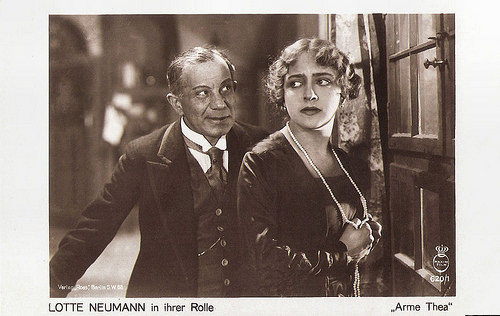
German postcard by Ross Verlag, no. 620/1. Photo: Maxim Film. Publicity still for Arme Thea/Poor Thea (Carl Froelich, 1919) with Lotte Neumann .
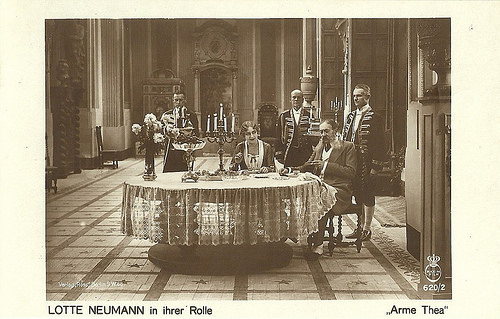
German postcard by Ross Verlag, no. 620/2. Photo: Maxim Film. Publicity still for Arme Thea/Poor Thea (Carl Froelich, 1919) with Lotte Neumann and Adolf Klein.
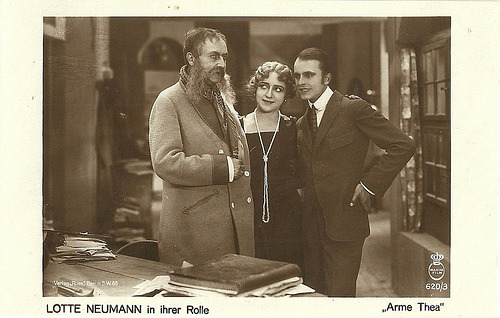
German postcard by Ross Verlag, no. 620/3. Photo: Maxim Film. Publicity still for Arme Thea/Poor Thea (Carl Froelich, 1919) with Adolf Klein, Lotte Neumann and Ernst Hofmann .
The daughter of a bailout
Lotte Neumann plays in Arme Thea/Poor Thea (Carl Froelich, 1919) Thea von Hoffäcker, daughter of a chamberlain, Freiherr von Hoffäcker (Adolf Klein).
Georg Textor ( Ernst Hofmann ), man about town and son of a well-to-do merchant, is betrothed to Thea. When one day Georg flunks at the races, and his future father-in-law bets on the wrong horse, Textor’s one namely, the situation is alarming. Hoffäcker, suddenly very short of cash, wants to borrow 50,000 Mark from his friend Raschdorf.
The promised money-sum does not arrive fast enough with the chamberlain, whose creditors are already on his neck. Hoping that the 50,000 marks arrive shortly, Hoffäcker writes a check secured by Raschdorf. But when Raschdorf suddenly dies of a stroke, Hoffäcker’s world collapses. His aristocratic relatives advise him to shoot himself, as is common in their milieu, but the man refuses and instead serves a one-year sentence for bribery in prison.
Poor Thea, unknown to what has fallen upon her father, is said he is on a secret diplomatic mission to the Far East. After one year Hoffäcker is released and with his former bookmaker Heinlein (Guido Herzfeld) he finds a small job at the editorial office of Turflaterne, a second rate racing track magazine.
Thea learns that her father has returned from his 'diplomatic mission' to Berlin. Immediately she visits him in his new, humble domicile. Nothing has remained of the proud representative of the upper-class official caste. Thea cannot explain the outer decay of her father and does not get any response from him.
Georg doesn’t know any more. He has just returned home from a trip to Mexico, where he tried - unsuccessfully - to initiate rescue measures for the family company that had been in a state of misery. Textor is now also broke, and as luck would have it, he also lands with Heinlein and his shabby magazine. Georg meets his future sister-in-law, learns of Hoffäcker's descent, and makes it clear to him that he does not intend to marry the daughter of a bailout.
However, Georg quickly regrets his harsh words and wants to apologise to Thea and her father. But Hoffäcker has finally followed his blue-blooded 'advice' and has shot himself. The guilt has now been eradicated, so Georg asks Thea to marry him.
Arme Thea/Poor Thea (Carl Froelich, 1919) was based on a novel by Rudolph Stratz. The sets were designed by Hans Sohnle. The film premiered in August 1919 at the Berlin cinema Kammerlichtspielen. Jupp Wiertz designed an elegant poster for the film.
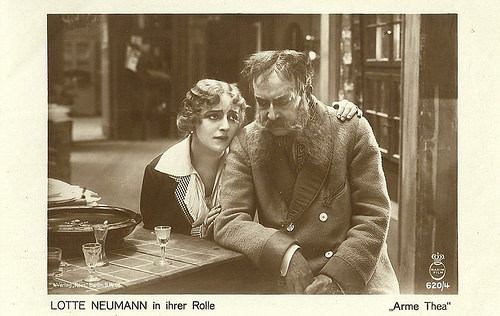
German postcard by Ross Verlag, no. 620/4. Photo: Maxim Film. Publicity still for Arme Thea/Poor Thea (Carl Froelich, 1919) with Lotte Neumann and Adolf Klein.
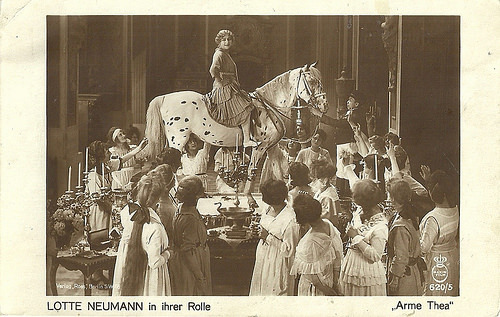
German postcard by Ross Verlag, no. 620/5. Photo: Maxim Film. Publicity still for Arme Thea/Poor Thea (Carl Froelich, 1919) with Lotte Neumann .
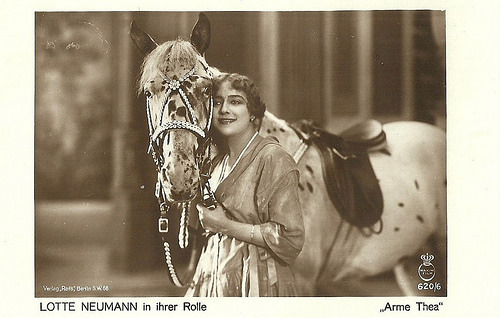
German postcard by Ross Verlag, no. 620/6. Photo: Maxim Film. Publicity still for Arme Thea/Poor Thea (Carl Froelich, 1919) with Lotte Neumann .
Source: The German Early Cinema Database, Wikipedia (German) and IMDb.

German postcard by Ross Verlag, no. 620/1. Photo: Maxim Film. Publicity still for Arme Thea/Poor Thea (Carl Froelich, 1919) with Lotte Neumann .

German postcard by Ross Verlag, no. 620/2. Photo: Maxim Film. Publicity still for Arme Thea/Poor Thea (Carl Froelich, 1919) with Lotte Neumann and Adolf Klein.

German postcard by Ross Verlag, no. 620/3. Photo: Maxim Film. Publicity still for Arme Thea/Poor Thea (Carl Froelich, 1919) with Adolf Klein, Lotte Neumann and Ernst Hofmann .
The daughter of a bailout
Lotte Neumann plays in Arme Thea/Poor Thea (Carl Froelich, 1919) Thea von Hoffäcker, daughter of a chamberlain, Freiherr von Hoffäcker (Adolf Klein).
Georg Textor ( Ernst Hofmann ), man about town and son of a well-to-do merchant, is betrothed to Thea. When one day Georg flunks at the races, and his future father-in-law bets on the wrong horse, Textor’s one namely, the situation is alarming. Hoffäcker, suddenly very short of cash, wants to borrow 50,000 Mark from his friend Raschdorf.
The promised money-sum does not arrive fast enough with the chamberlain, whose creditors are already on his neck. Hoping that the 50,000 marks arrive shortly, Hoffäcker writes a check secured by Raschdorf. But when Raschdorf suddenly dies of a stroke, Hoffäcker’s world collapses. His aristocratic relatives advise him to shoot himself, as is common in their milieu, but the man refuses and instead serves a one-year sentence for bribery in prison.
Poor Thea, unknown to what has fallen upon her father, is said he is on a secret diplomatic mission to the Far East. After one year Hoffäcker is released and with his former bookmaker Heinlein (Guido Herzfeld) he finds a small job at the editorial office of Turflaterne, a second rate racing track magazine.
Thea learns that her father has returned from his 'diplomatic mission' to Berlin. Immediately she visits him in his new, humble domicile. Nothing has remained of the proud representative of the upper-class official caste. Thea cannot explain the outer decay of her father and does not get any response from him.
Georg doesn’t know any more. He has just returned home from a trip to Mexico, where he tried - unsuccessfully - to initiate rescue measures for the family company that had been in a state of misery. Textor is now also broke, and as luck would have it, he also lands with Heinlein and his shabby magazine. Georg meets his future sister-in-law, learns of Hoffäcker's descent, and makes it clear to him that he does not intend to marry the daughter of a bailout.
However, Georg quickly regrets his harsh words and wants to apologise to Thea and her father. But Hoffäcker has finally followed his blue-blooded 'advice' and has shot himself. The guilt has now been eradicated, so Georg asks Thea to marry him.
Arme Thea/Poor Thea (Carl Froelich, 1919) was based on a novel by Rudolph Stratz. The sets were designed by Hans Sohnle. The film premiered in August 1919 at the Berlin cinema Kammerlichtspielen. Jupp Wiertz designed an elegant poster for the film.

German postcard by Ross Verlag, no. 620/4. Photo: Maxim Film. Publicity still for Arme Thea/Poor Thea (Carl Froelich, 1919) with Lotte Neumann and Adolf Klein.

German postcard by Ross Verlag, no. 620/5. Photo: Maxim Film. Publicity still for Arme Thea/Poor Thea (Carl Froelich, 1919) with Lotte Neumann .

German postcard by Ross Verlag, no. 620/6. Photo: Maxim Film. Publicity still for Arme Thea/Poor Thea (Carl Froelich, 1919) with Lotte Neumann .
Source: The German Early Cinema Database, Wikipedia (German) and IMDb.
Published on September 13, 2017 22:00
September 12, 2017
The Blue Diamonds: Riem de Wolff (1943-2017)
Last night, 11 September 2017, Dutch Indonesian singer and guitarist Riem de Wolff died at the age of 74. With his brother, Ruud de Wolff (1941-2000), he formed The Blue Diamonds, one of the most successful Dutch pop acts ever. Their hit song Ramona sold 7 million records and became an evergreen. Incidentally the brothers also acted in films and on TV.

Dutch postcard by SYBA/MUVA. Photo: Phonogram, Amsterdam.
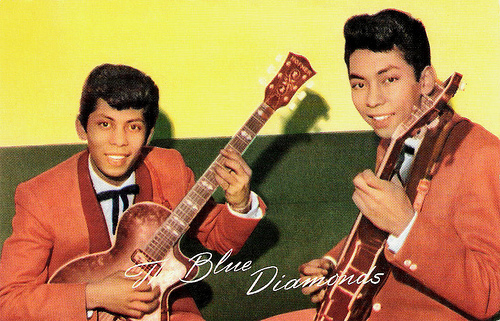
Dutch postcard.
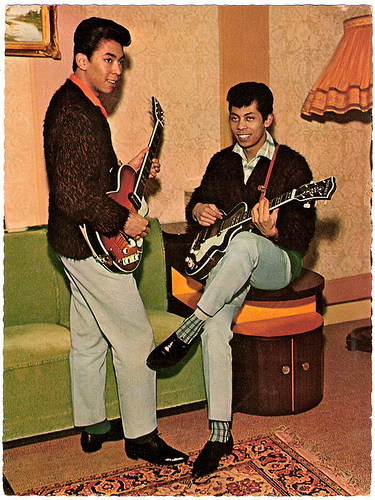
Dutch postcard by Gebr. Spanjersberg, Rotterdam.
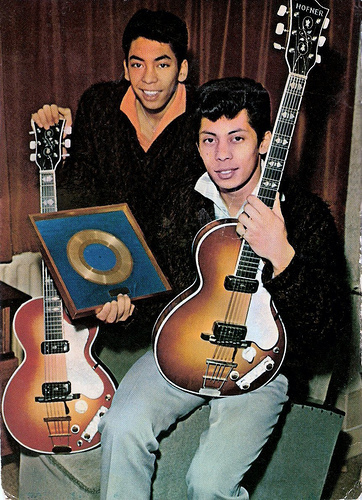
Dutch postcard by Gebr. Spanjersberg, Rotterdam. Publicity card for the release of the LP Till We Meet Again by Decca.
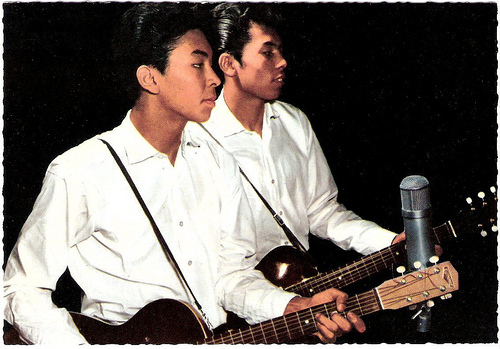
German postcard by ISV, no. H 66.
String Extase Boys
Ruud and Riem de Wolff were born in Batavia on the island of Java in the Dutch East Indies (now Jakarta, Indonesia). Ruud in Djakarta in 1941 and Riem in Depok in 1943.
In 194, they came to Holland together with their family. During their school years, they performed in bands like String Extase Boys and The Cool Cats. Those bands were exponents of the famous Indo-rock scene (Indo stands for Dutch Indonesian), the cradle for all Dutch rock music way back in the 1950s.
The Indo-rockers mixed their rural musical influences with the new Rock & Roll from the USA. In 1959 Ruud and Riem formed The Blue Diamonds, and recorded their first single, Till I Kissed You, a cover of the Everly Brothers. This was successfully followed by another cover, Oh Carol. They were so successful that The Everly Brothers forbade to cover more of their hits.
On instigation of producer Jack Bulterman the 'Dutch Everly Brothers' recorded in 1960 a song from 1927, Ramona. The song was originally written for the film Ramona (Edwin Carewe, 1928). It was not featured in the film itself, but was written for promotional appearances with the star of the film, Dolores del Rio .
The Blue Diamonds' up-tempo version of the slow waltz became a worldwide hit: number one in the Netherlands, Belgium, Switzerland, Austria, France, Spain, Germany, Japan, Thailand, and Indonesia, and it even reached the American Billboard Hot 100: #72. There were five different language versions of the song. The English version sold over 250,000 copies in the Netherlands (the first record to ever do so) and a German version sold over one million copies in Germany by 1961. By 1963 all Ramona versions together had sold seven million times, and The Blue Diamonds got the Dutch Edison award for the song.

Dutch postcard by De Gruyter, no. 6. (De Gruyter was a Dutch grocery chain, which enclosed postcards of "famous stars from the fascinating world of cinema and hit parade" with their soap Trexop).
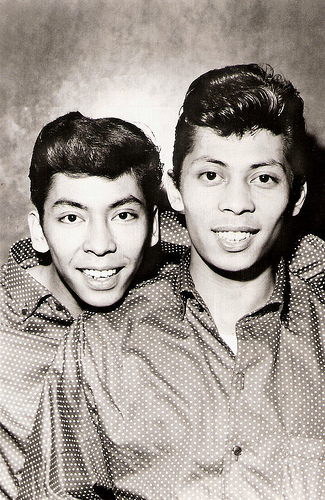
Dutch postcard by Gebr. Spanjersberg N.V., Rotterdam, for Decca, no. 57. Photo: Combi Press, Amsterdam.
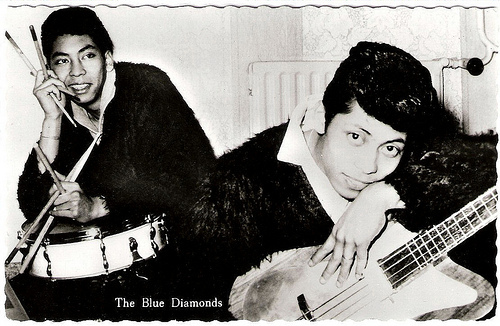
Dutch postcard.
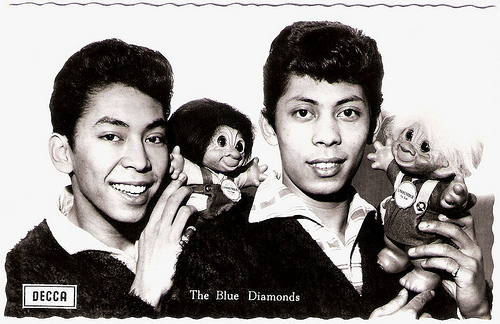
Dutch postcard for Decca, no. 907.
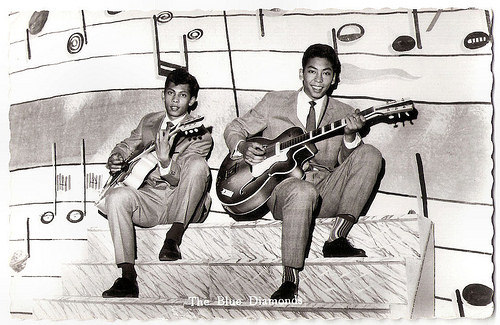
Dutch postcard by C.K.Z., Zeist, no. 387.
Schlagerfilms
As they had hits in the Netherlands with songs in English, The Blue Diamonds adapted their songs for the German market by translating them in German. Ramona became a golden record in Germany.
Their popularity lead to many appearances on German television, and also in two Schlagerfilms. The comedy Und du mein Schatz bleibst hier/And You My Dear Stay Here (Franz Antel, 1961) was an Austrian production with Vivi Bach , Hans Moser and Paul Hörbiger .
The German production Davon träumen alle Mädchen/That’s What All the Girls Dream Of (Thomas Engel, 1961) starred Harald Juhnke and Marion Michael .
Their hit Ramona was the title song of another Schlagerfilm, Ramona (Paul Martin, 1961) starring Senta Berger , but in the film the song was interpreted by Willy Hagara .
The Blue Diamonds had more hits in Germany like Wie damals in Paris (1961), Little Ship/Blaues Boot der Sehnsucht (1962) and Sukiyaki (1963), but their military service (1964-1966) and the rise of the Mersey Beat slowed down their careers. Their last German hit was Gib dein Wort, Linda Lou (1965) which they performed at the Deutschen Schlager-Festspielen. They reached the 6th place at this contest.

Dutch postcard.
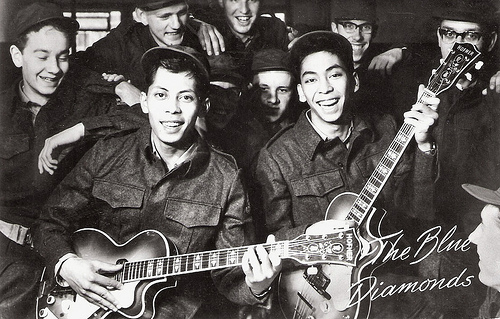
Dutch postcard by Uitg. Takken, Utrecht, no. 4992. Photo: N.V. Phonogram, Amsterdam.
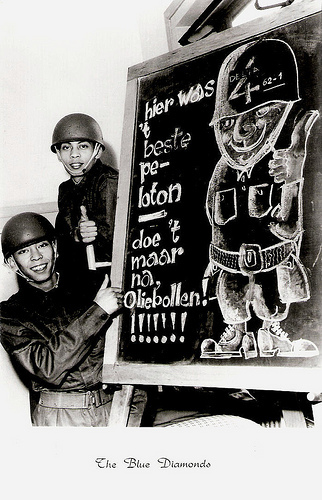
Dutch postcard by Hercules, Haarlem, no. 662.
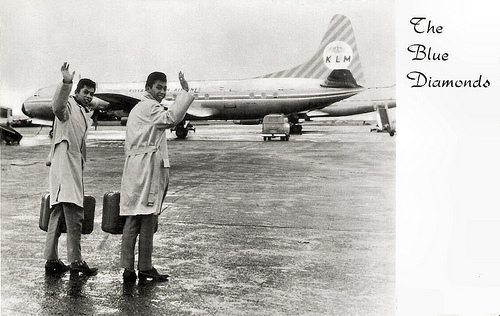
Dutch postcard by Gebr. Spanjersberg N.V., Rotterdam, no. 5754.
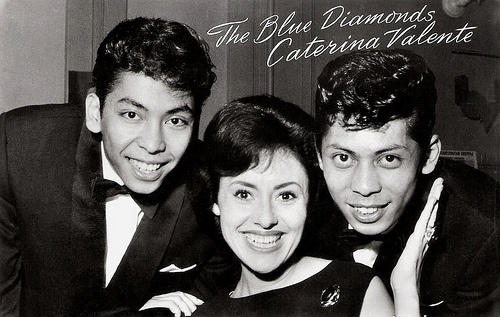
With Caterina Valente . Dutch postcard by Uitg. Takken, Utrecht, no. AX 4821. Photo: Decca.
Last Hit
During the late 1960s and the 1970s Ruud and Riem de Wolff toured around the world, and especially in Western Europe and the Far East they stayed popular. From 1970 till 1972 they performed in the Dutch stage musical Tien miljoen geboden (Ten Million Commandments) by Seth Gaaikema, which was a huge success.
In 1971 they had a hit in Germany again with Ja, es steht schon bei den Propheten geschrieben/Nimm mich mit nach Capriciano. Since then they continued to perform on stage and TV.
In 1990 Ruud was offered the leading part in the film My Blue Heaven (Ronald Beer, 1990). The Dutch film told the story of an Indo family who starts a restaurant, that is burned down by racists. The film was not a commercial success, and Ruud’s film appearance was not repeated.
The Blue Diamonds was one of the few bands in the world where only death of one of the members could take it apart. Ruud de Wollf died, not very long after the group's last appearance at the end of 2000. They had recorded circa 130 records, which sold over 20 million copies.
After his brother's death Riem de Wolff first wanted to stop, but he decided to continue to perform and release albums. He appeared in the Dutch film Ver van familie/Far Away From Family (Marion Bloem, 2008), an adaptation of a novel of its director. Marion Bloem is also of Dutch Indonesian heritage, and told the tale of a young woman, who, following the death of her stepmother, leaves her life in the USA behind, and rekindles the bonds with her Indonesian-Dutch grandmother.
In 1987 the listeners to the Dutch Radio 5 station chose Ramona as the Best Pop Hit of the 1960s. The Blue Diamonds stood on top of the Dutch music scene and far beyond its borders for 40 years. Riem de Wolff continued to perform, now with his son as The New Diamonds. Last week he had a hemorrhage, followed by a second one this weekend. Monday night, he died peacefully, surrounded by his family. He was 74.
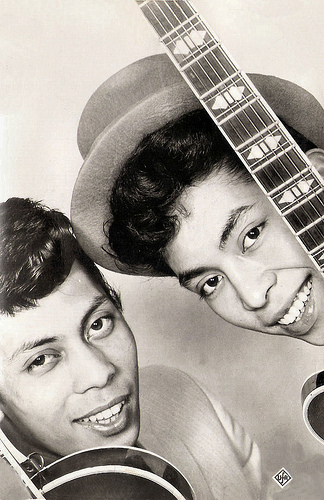
German postcard by Ufa.
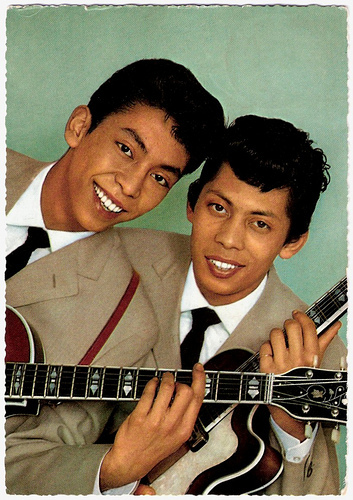
German postcard by Krüger, sent by mail in 1964. At the backside is an advertisement for the single Ramona and other Fontana records of The Blue Diamonds.
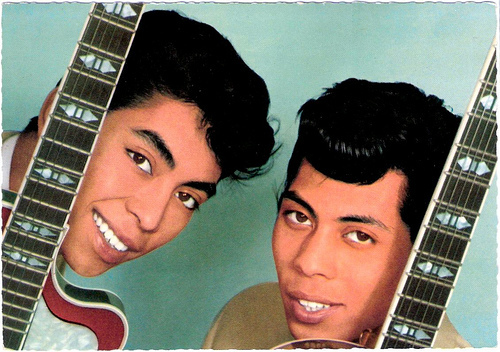
German postcard by ISV, no. H 83. Photo: Philips. Please double-click to see this picture better.

German postcard by ISV, no. H 84.

Dutch postcard by Emdeeha B.V., Oosterbeek, for Bobos Jeans and Jackets.
Ramona (1960) by The Blue Diamonds. Source: Roquitoyo (YouTube).
Sources: Blue Diamonds.nl, , and Wikipedia (English and German).

Dutch postcard by SYBA/MUVA. Photo: Phonogram, Amsterdam.

Dutch postcard.

Dutch postcard by Gebr. Spanjersberg, Rotterdam.

Dutch postcard by Gebr. Spanjersberg, Rotterdam. Publicity card for the release of the LP Till We Meet Again by Decca.

German postcard by ISV, no. H 66.
String Extase Boys
Ruud and Riem de Wolff were born in Batavia on the island of Java in the Dutch East Indies (now Jakarta, Indonesia). Ruud in Djakarta in 1941 and Riem in Depok in 1943.
In 194, they came to Holland together with their family. During their school years, they performed in bands like String Extase Boys and The Cool Cats. Those bands were exponents of the famous Indo-rock scene (Indo stands for Dutch Indonesian), the cradle for all Dutch rock music way back in the 1950s.
The Indo-rockers mixed their rural musical influences with the new Rock & Roll from the USA. In 1959 Ruud and Riem formed The Blue Diamonds, and recorded their first single, Till I Kissed You, a cover of the Everly Brothers. This was successfully followed by another cover, Oh Carol. They were so successful that The Everly Brothers forbade to cover more of their hits.
On instigation of producer Jack Bulterman the 'Dutch Everly Brothers' recorded in 1960 a song from 1927, Ramona. The song was originally written for the film Ramona (Edwin Carewe, 1928). It was not featured in the film itself, but was written for promotional appearances with the star of the film, Dolores del Rio .
The Blue Diamonds' up-tempo version of the slow waltz became a worldwide hit: number one in the Netherlands, Belgium, Switzerland, Austria, France, Spain, Germany, Japan, Thailand, and Indonesia, and it even reached the American Billboard Hot 100: #72. There were five different language versions of the song. The English version sold over 250,000 copies in the Netherlands (the first record to ever do so) and a German version sold over one million copies in Germany by 1961. By 1963 all Ramona versions together had sold seven million times, and The Blue Diamonds got the Dutch Edison award for the song.

Dutch postcard by De Gruyter, no. 6. (De Gruyter was a Dutch grocery chain, which enclosed postcards of "famous stars from the fascinating world of cinema and hit parade" with their soap Trexop).

Dutch postcard by Gebr. Spanjersberg N.V., Rotterdam, for Decca, no. 57. Photo: Combi Press, Amsterdam.

Dutch postcard.

Dutch postcard for Decca, no. 907.

Dutch postcard by C.K.Z., Zeist, no. 387.
Schlagerfilms
As they had hits in the Netherlands with songs in English, The Blue Diamonds adapted their songs for the German market by translating them in German. Ramona became a golden record in Germany.
Their popularity lead to many appearances on German television, and also in two Schlagerfilms. The comedy Und du mein Schatz bleibst hier/And You My Dear Stay Here (Franz Antel, 1961) was an Austrian production with Vivi Bach , Hans Moser and Paul Hörbiger .
The German production Davon träumen alle Mädchen/That’s What All the Girls Dream Of (Thomas Engel, 1961) starred Harald Juhnke and Marion Michael .
Their hit Ramona was the title song of another Schlagerfilm, Ramona (Paul Martin, 1961) starring Senta Berger , but in the film the song was interpreted by Willy Hagara .
The Blue Diamonds had more hits in Germany like Wie damals in Paris (1961), Little Ship/Blaues Boot der Sehnsucht (1962) and Sukiyaki (1963), but their military service (1964-1966) and the rise of the Mersey Beat slowed down their careers. Their last German hit was Gib dein Wort, Linda Lou (1965) which they performed at the Deutschen Schlager-Festspielen. They reached the 6th place at this contest.

Dutch postcard.

Dutch postcard by Uitg. Takken, Utrecht, no. 4992. Photo: N.V. Phonogram, Amsterdam.

Dutch postcard by Hercules, Haarlem, no. 662.

Dutch postcard by Gebr. Spanjersberg N.V., Rotterdam, no. 5754.

With Caterina Valente . Dutch postcard by Uitg. Takken, Utrecht, no. AX 4821. Photo: Decca.
Last Hit
During the late 1960s and the 1970s Ruud and Riem de Wolff toured around the world, and especially in Western Europe and the Far East they stayed popular. From 1970 till 1972 they performed in the Dutch stage musical Tien miljoen geboden (Ten Million Commandments) by Seth Gaaikema, which was a huge success.
In 1971 they had a hit in Germany again with Ja, es steht schon bei den Propheten geschrieben/Nimm mich mit nach Capriciano. Since then they continued to perform on stage and TV.
In 1990 Ruud was offered the leading part in the film My Blue Heaven (Ronald Beer, 1990). The Dutch film told the story of an Indo family who starts a restaurant, that is burned down by racists. The film was not a commercial success, and Ruud’s film appearance was not repeated.
The Blue Diamonds was one of the few bands in the world where only death of one of the members could take it apart. Ruud de Wollf died, not very long after the group's last appearance at the end of 2000. They had recorded circa 130 records, which sold over 20 million copies.
After his brother's death Riem de Wolff first wanted to stop, but he decided to continue to perform and release albums. He appeared in the Dutch film Ver van familie/Far Away From Family (Marion Bloem, 2008), an adaptation of a novel of its director. Marion Bloem is also of Dutch Indonesian heritage, and told the tale of a young woman, who, following the death of her stepmother, leaves her life in the USA behind, and rekindles the bonds with her Indonesian-Dutch grandmother.
In 1987 the listeners to the Dutch Radio 5 station chose Ramona as the Best Pop Hit of the 1960s. The Blue Diamonds stood on top of the Dutch music scene and far beyond its borders for 40 years. Riem de Wolff continued to perform, now with his son as The New Diamonds. Last week he had a hemorrhage, followed by a second one this weekend. Monday night, he died peacefully, surrounded by his family. He was 74.

German postcard by Ufa.

German postcard by Krüger, sent by mail in 1964. At the backside is an advertisement for the single Ramona and other Fontana records of The Blue Diamonds.

German postcard by ISV, no. H 83. Photo: Philips. Please double-click to see this picture better.

German postcard by ISV, no. H 84.

Dutch postcard by Emdeeha B.V., Oosterbeek, for Bobos Jeans and Jackets.
Ramona (1960) by The Blue Diamonds. Source: Roquitoyo (YouTube).
Sources: Blue Diamonds.nl, , and Wikipedia (English and German).
Published on September 12, 2017 14:00
September 11, 2017
Maria Fromet
Maria Fromet (1902-1967), aka 'la petite Fromet', is mostly known for her countless parts as a little girl in the films by Pathé Frères of the early 1910s.
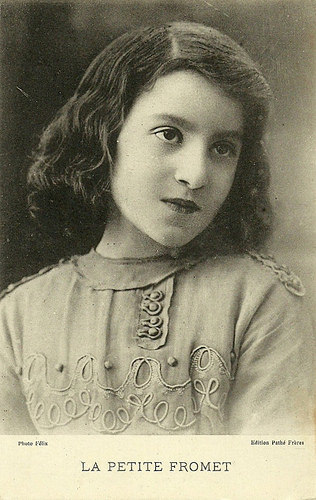
French postcard by Edition Pathé Frères. Photo: Félix.
La petite Fromet
Marie Léonie Fromet was born in 1902 in Chauny, Picardie, France. She was the daughter of the stage actors Paul and Marie Fromet. In 1906, Maria started to appear on stage at the age of four. It was the time when the French theatre was ruled by stars such as Réjane, Mistinguett , and Lucien Guitry.
In 1908, Fromet played in L'Oiseau bleu (The Blue Bird) by Maurice Maeterlinck. At the same time, her name was mentioned for the first time in the distribution of a film: Les Orphelins/The Orphans (Victorin-Hippolyte Jasset, 1908), a production by La Société Française des Films Éclair with Eugénie Nau.
It was in 1909 that Maria Fromet entered the Pathé stable, where directors Michel Carré, Georges Denola, Camille de Morlhon, and Georges Monca made her the inevitable little girl of the cinema of the day. She often struggled with evil characters, sometimes she was abandoned, or evolved on the contrary in comedy plots. An example is La récompense d'une bonne action/A Kindness Never Goes Unrewarded (Camille de Morlhon, 1909) in which a little rich girl is kidnapped by ruffians, but is saved by a little barefooted girl whom she earlier handed some pennies.
Publicity called her ‘la petite Fromet’ (little Fromet) and in some films her parents and her sisters - actresses too - were her partners. She appeared in the amusing comedy La tournée des grands ducs/The Grand Dukes Tour (Léonce Perret, 1910) with Polaire doing an Apache dance.
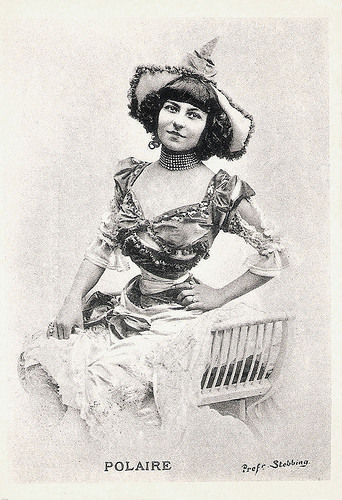
Polaire . French postcard. Photo: Stebbing.
Cosette
In 1910 Albert Capellani directed Maria Fromet for the first time in the drama Athalie (Albert Capellani, Michel Carré, 1910) with Édouard de Max . She would be his performer in at least six films in three years.
Her starring role was that of Cosette in Capellani's four-part Victor Hugo adaptation Les Misérables (Albert Capellani, 1912) with Henry Krauss as Jean Valjean. In this film, Fromet showed real qualities as an actress, with remarkable finesse and the right tones.
Unfortunately for her career, Maria Fromet grew up too fast, and as early as 1913 the catalogues no longer called her "little" but just "Maria Fromet". So no more child roles were offered. On the stage of the Grand-Guignol she played in 1914 a teenage girl strangled by a madman in Les Morts étranges d'Albury by Albert-Jean. The rest of her trajectory was difficult, the roles less and less numerous.
After L’Ile sans nom/The Nameless Island (René Plaissetty, 1922), a big gap in her film career followed until a minor role in Jean Grémillon's silent film Gardiens de phare/The Lighthouse Keepers (1929) with her father Paul Fromet in the leading role.
In the theatre, Maria Fromet took her revenge, creating Mélo by Henri Bernstein in 1929. On screen she played a minor part in the film adaptation Mélo/The Dreamy Mouth (Paul Czinner, 1932), starring Gaby Morlay , Pierre Blanchar and Victor Francen.
Then Maria Fromet played in pieces by Édouard Bourdet: Les Temps difficiles and Margot. She was engaged by the Comédie-Française in 1937, where she played the classical and modern repertoire until her retirement. She also did a handful of minor film parts in the early 1930s and some occasional ones after that.
Maria Fromet died in Paris in 1967. She was 64. All in all she acted in over 100, mostly short, films.
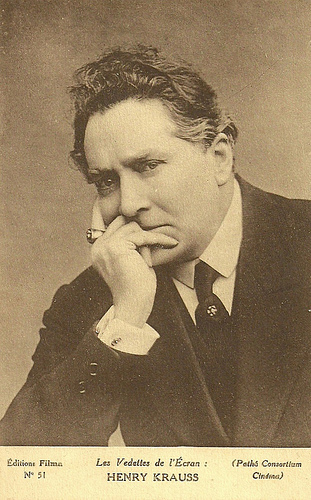
Henry Krauss . French postcard in the Les Vedettes de l' Écran series by Editions Filma, no. 51. Photo: Pathé Consortium Cinéma.
Source: Jacques Richard (1895 - French) and .

French postcard by Edition Pathé Frères. Photo: Félix.
La petite Fromet
Marie Léonie Fromet was born in 1902 in Chauny, Picardie, France. She was the daughter of the stage actors Paul and Marie Fromet. In 1906, Maria started to appear on stage at the age of four. It was the time when the French theatre was ruled by stars such as Réjane, Mistinguett , and Lucien Guitry.
In 1908, Fromet played in L'Oiseau bleu (The Blue Bird) by Maurice Maeterlinck. At the same time, her name was mentioned for the first time in the distribution of a film: Les Orphelins/The Orphans (Victorin-Hippolyte Jasset, 1908), a production by La Société Française des Films Éclair with Eugénie Nau.
It was in 1909 that Maria Fromet entered the Pathé stable, where directors Michel Carré, Georges Denola, Camille de Morlhon, and Georges Monca made her the inevitable little girl of the cinema of the day. She often struggled with evil characters, sometimes she was abandoned, or evolved on the contrary in comedy plots. An example is La récompense d'une bonne action/A Kindness Never Goes Unrewarded (Camille de Morlhon, 1909) in which a little rich girl is kidnapped by ruffians, but is saved by a little barefooted girl whom she earlier handed some pennies.
Publicity called her ‘la petite Fromet’ (little Fromet) and in some films her parents and her sisters - actresses too - were her partners. She appeared in the amusing comedy La tournée des grands ducs/The Grand Dukes Tour (Léonce Perret, 1910) with Polaire doing an Apache dance.

Polaire . French postcard. Photo: Stebbing.
Cosette
In 1910 Albert Capellani directed Maria Fromet for the first time in the drama Athalie (Albert Capellani, Michel Carré, 1910) with Édouard de Max . She would be his performer in at least six films in three years.
Her starring role was that of Cosette in Capellani's four-part Victor Hugo adaptation Les Misérables (Albert Capellani, 1912) with Henry Krauss as Jean Valjean. In this film, Fromet showed real qualities as an actress, with remarkable finesse and the right tones.
Unfortunately for her career, Maria Fromet grew up too fast, and as early as 1913 the catalogues no longer called her "little" but just "Maria Fromet". So no more child roles were offered. On the stage of the Grand-Guignol she played in 1914 a teenage girl strangled by a madman in Les Morts étranges d'Albury by Albert-Jean. The rest of her trajectory was difficult, the roles less and less numerous.
After L’Ile sans nom/The Nameless Island (René Plaissetty, 1922), a big gap in her film career followed until a minor role in Jean Grémillon's silent film Gardiens de phare/The Lighthouse Keepers (1929) with her father Paul Fromet in the leading role.
In the theatre, Maria Fromet took her revenge, creating Mélo by Henri Bernstein in 1929. On screen she played a minor part in the film adaptation Mélo/The Dreamy Mouth (Paul Czinner, 1932), starring Gaby Morlay , Pierre Blanchar and Victor Francen.
Then Maria Fromet played in pieces by Édouard Bourdet: Les Temps difficiles and Margot. She was engaged by the Comédie-Française in 1937, where she played the classical and modern repertoire until her retirement. She also did a handful of minor film parts in the early 1930s and some occasional ones after that.
Maria Fromet died in Paris in 1967. She was 64. All in all she acted in over 100, mostly short, films.

Henry Krauss . French postcard in the Les Vedettes de l' Écran series by Editions Filma, no. 51. Photo: Pathé Consortium Cinéma.
Source: Jacques Richard (1895 - French) and .
Published on September 11, 2017 22:00
September 10, 2017
René Poyen
René Poyen (1908-1968) was a talented child star of the silent French cinema. He started at the age of four as the popular character Bout-de-Zan (Tiny Tim) in a popular series based on the adventures of little rascals in cute hats. Most of these burlesque comedies were filmed between 1912 and 1916 by Louis Feuillade for the Gaumont company.
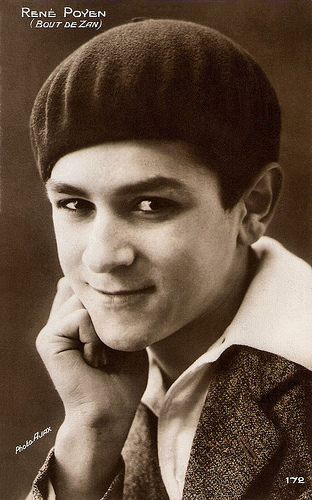
French postcard by Cinémagazine, no. 172. Photo: Ajax.
Rascal Kid Actor
René-Georges Poyen was born in Paris, France, in 1908.
In 1912, he started his film career at Gaumont as Bout-de-Zan, the younger brother of rascal kid actor Bébé ( René Dary ), in the film comedy Bébé adopte un petit frère/Baby takes a little brother (Louis Feuillade, 1912).
Quite soon he replaced Dary and his character, becoming the child star of Gaumont in the subsequent years. Urbanora writes at The Bioscope : "Greater comic emphasis was placed on Bout-de-Zan being an ‘adult’ figure, as he dressed like an adult, aped adult mannerisms, and was generally an earthier character than Bébé. He would also often giving knowing looks to the camera, making the audience complicit in his trickery. "
Already in 1913 Poyen made 24 one-reelers with his popular mischievous alter ego; 16 in 1914; and 18 in 1915. That year he also played a small role in Louis Feuillade's famous crime serial Les Vampires/The Vampires (1915) starring Musidora as the mysterious Irma Vep, dressed in a black tights.
In 1917 he played 'The Licorice Kid' in another popular Feuillade serial Judex, featuring René Cresté as a caped superhero. He also appeared in the crime parody Le pied qui étreint (Jacques Feyder, 1917), and a handful of Bout-de-Zan shorts.
By then the era of the short Bout-de-Zan comedies was over, but Poyen continued to play in crime serials like La nouvelle mission de Judex (Louis Feuillade, 1917).
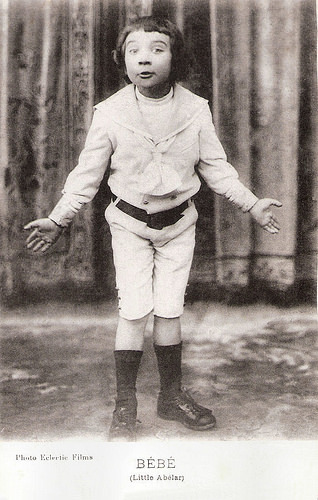
Bébé ( René Dary ). French postcard. Photo Eclectic Films.
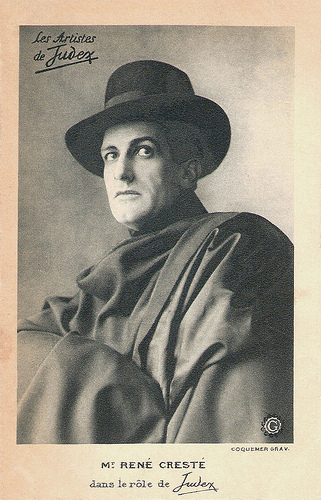
René Cresté . French postcard by Coquemer Gravures. Photo: Gaumont. Still for La nouvelle mission de Judex (Louis Feuillade, 1917-1918).
Bouboule
René Poyen appeared for Feuillade in the serial Les deux gamines/The Two Girls (Louis Feuillade, 1920), and the series films L'orphelin de Paris/The Orphan of Paris (Louis Feuillade, 1924).
He also performed in the features La proie (Marcel Dumont, 1921), La fille bien gardée (Louis Feuillade, 1923-1924), Romanetti/Le roi du maquis (Gennaro Dini, 1924), and Les murailles du silence (Louis de Carbonnat, 1925).
In the early 1920s, he was often paired with girl actress Bouboule, as in Le gamin de Paris/Paris Urchin (Louis Feuillade, 1923), La gosseline (Louis Feuillade, 1923), Pierrot, Pierrette (Louis Feuillade, 1924), and Lucette (Louis Feuillade, Maurice Champreux, 1924).
In the sound era, Poyen returned only twice more in films, in an uncredited role in Clochard/Tramp (Robert Péguy, 1932) and a last time as Bout-de-Zan in the comedy Le Bidon d'or/The Golden Canister (Christian Jaque, 1932).
René Poyen died in his hometown Paris in 1968.
Bout-de-Zan vole un éléphant/Bout de Zan Steals an Elephant (Louis Feuillade, 1913). Source: Tonytony 9292 (YouTube).
Bout-de-Zan Et L'Embusqué/Bout de Zan and the Shirker (Louis Feuillade, 1916). Source: Mau M (YouTube).
Sources: Urbanora (The Bioscope), Turner Classic Movies, and Wikipedia (French).

French postcard by Cinémagazine, no. 172. Photo: Ajax.
Rascal Kid Actor
René-Georges Poyen was born in Paris, France, in 1908.
In 1912, he started his film career at Gaumont as Bout-de-Zan, the younger brother of rascal kid actor Bébé ( René Dary ), in the film comedy Bébé adopte un petit frère/Baby takes a little brother (Louis Feuillade, 1912).
Quite soon he replaced Dary and his character, becoming the child star of Gaumont in the subsequent years. Urbanora writes at The Bioscope : "Greater comic emphasis was placed on Bout-de-Zan being an ‘adult’ figure, as he dressed like an adult, aped adult mannerisms, and was generally an earthier character than Bébé. He would also often giving knowing looks to the camera, making the audience complicit in his trickery. "
Already in 1913 Poyen made 24 one-reelers with his popular mischievous alter ego; 16 in 1914; and 18 in 1915. That year he also played a small role in Louis Feuillade's famous crime serial Les Vampires/The Vampires (1915) starring Musidora as the mysterious Irma Vep, dressed in a black tights.
In 1917 he played 'The Licorice Kid' in another popular Feuillade serial Judex, featuring René Cresté as a caped superhero. He also appeared in the crime parody Le pied qui étreint (Jacques Feyder, 1917), and a handful of Bout-de-Zan shorts.
By then the era of the short Bout-de-Zan comedies was over, but Poyen continued to play in crime serials like La nouvelle mission de Judex (Louis Feuillade, 1917).

Bébé ( René Dary ). French postcard. Photo Eclectic Films.

René Cresté . French postcard by Coquemer Gravures. Photo: Gaumont. Still for La nouvelle mission de Judex (Louis Feuillade, 1917-1918).
Bouboule
René Poyen appeared for Feuillade in the serial Les deux gamines/The Two Girls (Louis Feuillade, 1920), and the series films L'orphelin de Paris/The Orphan of Paris (Louis Feuillade, 1924).
He also performed in the features La proie (Marcel Dumont, 1921), La fille bien gardée (Louis Feuillade, 1923-1924), Romanetti/Le roi du maquis (Gennaro Dini, 1924), and Les murailles du silence (Louis de Carbonnat, 1925).
In the early 1920s, he was often paired with girl actress Bouboule, as in Le gamin de Paris/Paris Urchin (Louis Feuillade, 1923), La gosseline (Louis Feuillade, 1923), Pierrot, Pierrette (Louis Feuillade, 1924), and Lucette (Louis Feuillade, Maurice Champreux, 1924).
In the sound era, Poyen returned only twice more in films, in an uncredited role in Clochard/Tramp (Robert Péguy, 1932) and a last time as Bout-de-Zan in the comedy Le Bidon d'or/The Golden Canister (Christian Jaque, 1932).
René Poyen died in his hometown Paris in 1968.
Bout-de-Zan vole un éléphant/Bout de Zan Steals an Elephant (Louis Feuillade, 1913). Source: Tonytony 9292 (YouTube).
Bout-de-Zan Et L'Embusqué/Bout de Zan and the Shirker (Louis Feuillade, 1916). Source: Mau M (YouTube).
Sources: Urbanora (The Bioscope), Turner Classic Movies, and Wikipedia (French).
Published on September 10, 2017 22:00
September 9, 2017
Sandrine Bonnaire
Sandrine Bonnaire (1967) is a French actress, film director and screenwriter, who has appeared in more than 40 films. She won the César Award for Most Promising Actress for À nos amours (1983), the César Award for Best Actress for Sans toit ni loi (1985) and the Volpi Cup for Best Actress for La Cérémonie (1995). Her other films include Sous le soleil de Satan (1987), and Monsieur Hire (1989).
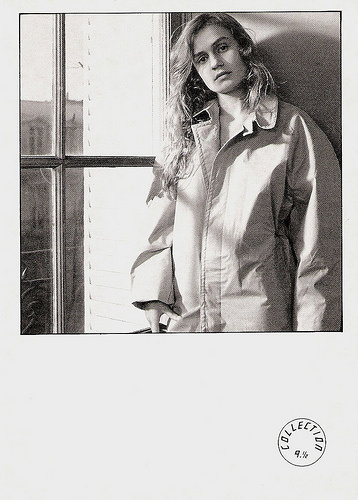
French postcard in the Collection 91/2 series by Editions Humour à la carte, Paris, no. ST-70.
Vagabond
Sandrine Bonnaire was born in 1967 in the town of Gannat, Allier, in the Auvergne region. She was born into a working-class family, the seventh of eleven children.
Her acting career began at the age of 16 in 1983, when she starred in the film À nos amours/For Our Loves (Maurice Pialat, 1983). She played Suzanne, a sixteen-year-old girl from Paris, who engages in a number of affairs in reaction to her miserable situation at home.
David Anderson reviews at his blog Bunched Undies : "Just when you expect another titillating French romantic drama about young girls and lost innocence, Maurice Pialat takes us on a surprising and highly subjective guided tour of a damaged family’s personal pain. The film is comprised of shifting alliances and points of view, and presents the fragility of family dynamics in ways that range from subtle to harrowing."
The film won the Prix Louis-Delluc for Best Film in 1983 and the César Award for Best Film in 1984. Bonnaire was also awarded the César Award in 1984 for Most Promising Actress.
With Pialat, she also made the romantic crime drama Police (Maurice Pialat, 1985). Written by Catherine Breillat, the film is about a moody, jaded police detective ( Gérard Depardieu ) who starts to investigate a Tunisian drug ring, falls for a mysterious woman ( Sophie Marceau ) and is drawn into a shady and dangerous scheme.
Bonnaire’s international breakthrough came when she played the main character, Mona, in Sans toit ni loi/Vagabond (1986), directed by Agnès Varda, for which she won her second César Award. Mona is a vagabond, who wanders through French wine country one winter and fails both physically and morally. The acclaimed film combines straightforward narrative scenes, in which we see Mona living her life, with pseudo-documentary sequences in which people who knew Mona turn to the camera and comment on what they remember about her. Significant events are sometimes left unshown, so that the viewer must piece the information together to gain a full picture.
Then followed the French-Belgian drama La Puritaine/The Prude (Jacques Doillon, 1986) with Michel Piccoli , and another drama with Pialat Sous le soleil de Satan/Under the Sun of Satan (Maurice Pialat, 1987), starring Gérard Depardieu as a devout priest who tries to save the soul of Mouchette, a young girl who killed one of her lovers. The film won the Palme d'Or at the 1987 Cannes Film Festival.
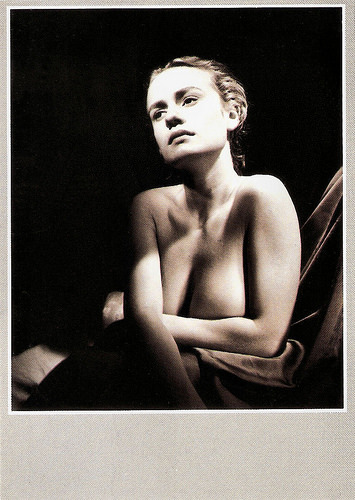
French postcard in the Le jour se lève series by Editions Humour à la carte, Paris, no. ST-169. Photo: Jean-Pierre Larcher.
Object of Affection
Sandrine Bonnaire starred as a girl who, whilst looking for her runaway brother, encounters a number of people who influence her life in another acclaimed drama, Les Innocents/The Innocents (André Téchiné, 1987).The film was partially inspired by a William Faulkner novel. Téchiné uses several French-Arab relationships to mirror the tensions between France and its former colonies. The film was nominated to four César Awards.
Her next film, Quelques jours avec moi/A Few Days with Me (Claude Sautet, 1988) with Daniel Auteuil, received three nominations at the 1989 César Awards.
An international success was Monsieur Hire (Patrice Leconte, 1989) starring Michel Blanc in the title role and Sandrine Bonnaire as the object of Hire's affection. The screenplay was based on the novel Les Fiançailles de M. Hire by Georges Simenon and is a remake of Julien Duvivier's film Panique/Panic (1947) with Michel Simon and Viviane Romance .
Bonnaire won new accolades with her leading role in the drama La captive du désert/Captive of the Desert (Raymond Depardon, 1990), which was entered into the 1990 Cannes Film Festival. The film was based in part on the experiences of Françoise Claustre who was captured by Chadian rebels in 1974, later joined by her husband, and the pair was finally released in 1977.
Sandrine Bonnaire played Joan of Arc in the two-part film Jeanne la pucelle/Joan the Maiden (Jacques Rivette, 1994).
In 1995, she starred as an apparently simple maid in the widely acclaimed thriller La Cérémonie (Claude Chabrol, 1995), also with Isabelle Huppert. The film echoes the case of Christine and Lea Papin, two French maids who brutally murdered their employer's wife and daughter in 1933. The film and its stars won awards internationally, including for Best Actress at the Venice Film Festival for both Bonnaire and Huppert. She reunited with Chabrol for the sociological mystery Au cœur du mensonge/The Color of Lies (Claude Chabrol, 1999).
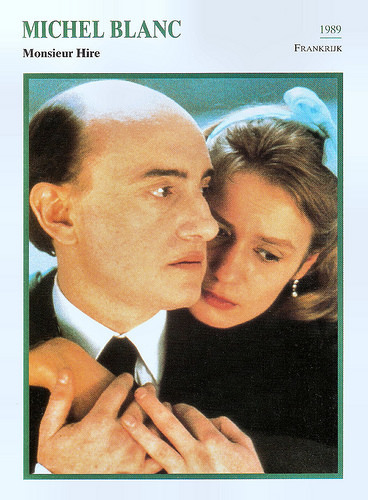
Dutch collectors card in the series 'Filmsterren: een portret' by Edito Service, 1995. Photo: Collection Christophe L. Publicity still for Monsieur Hire (Patrice Leconte, 1989) with Michel Blanc.
Intimate Strangers
In 2004, Sandrine Bonnaire starred with Fabrice Luchini in another film by Patrice Leconte, Confidences trop intimes/Intimate Strangers, which was an arthouse box office hit in the United States. She played a troubled woman, who on her initial appointment seeking psychiatric counseling, mistakenly enters a tax accountant's office, and an unusual relationship develops.
David Anderson at Bunched Undies : "It is a credit to the acumen of Luchini and Bonnaire that the story remains squarely on track as, on paper, it seems a bit far-fetched, yet there is never a moment here that feels forced or manipulative. Leconte presents a number of interesting observations on the nature of therapy itself by having virtually every character in the film, at one time or another, offer help and advice, usually with results that are more amusing than beneficial. Bonnaire’s ham-fisted attempt to cure a claustrophobic man is a welcome bit of comic relief, and reinforces the idea that therapy should usually be left to the professionals."
Her later films include Un cœur simple/A Simple Heart (Marion Laine, 2008) an adaptation of one of Gustave Flaubert's Three Tales, Salaud, on t'aime (Claude Lelouch, 2014) with Johnny Hallyday, and the international thriller Dusha shpiona/The Soul of a Spy (Vladimir Bortko, 2015).
Bonnaire has a daughter, Jeanne (1994), from a relationship with actor William Hurt, whom she met in 1991 during filming of the Albert Camus novel La Peste/The Plague (Luis Puenzo, 1991). They acted together in the international crime drama Ispoved neznakomtsu/Secrets Shared with a Stranger (Georges Bardawil, 1995).
From 2003 till 2015 she was married to actor and screenwriter Guillaume Laurant, with whom she had a second daughter, Adèle (2004). Sandrine Bonnaire’s latest film is Prendre le large (Gael Morel, 2017) in which she plays a middle-aged factory worker, whose life is upended when she follows her employer to Morocco.
French trailer for À nos amours/For Our Loves (Maurice Pialat, 1983). Source: Gaumont (YouTube).
French trailer for Sans toit ni loi/Vagabond (Agnes Varda, 1986). Source: cinetamaris (YouTube)>
DVD Trailer Monsieur Hire (Patrice Leconte, 1989). Source: KinoInternational (YouTube).
Sources: David Anderson (Bunched Undies), Wikipedia and .

French postcard in the Collection 91/2 series by Editions Humour à la carte, Paris, no. ST-70.
Vagabond
Sandrine Bonnaire was born in 1967 in the town of Gannat, Allier, in the Auvergne region. She was born into a working-class family, the seventh of eleven children.
Her acting career began at the age of 16 in 1983, when she starred in the film À nos amours/For Our Loves (Maurice Pialat, 1983). She played Suzanne, a sixteen-year-old girl from Paris, who engages in a number of affairs in reaction to her miserable situation at home.
David Anderson reviews at his blog Bunched Undies : "Just when you expect another titillating French romantic drama about young girls and lost innocence, Maurice Pialat takes us on a surprising and highly subjective guided tour of a damaged family’s personal pain. The film is comprised of shifting alliances and points of view, and presents the fragility of family dynamics in ways that range from subtle to harrowing."
The film won the Prix Louis-Delluc for Best Film in 1983 and the César Award for Best Film in 1984. Bonnaire was also awarded the César Award in 1984 for Most Promising Actress.
With Pialat, she also made the romantic crime drama Police (Maurice Pialat, 1985). Written by Catherine Breillat, the film is about a moody, jaded police detective ( Gérard Depardieu ) who starts to investigate a Tunisian drug ring, falls for a mysterious woman ( Sophie Marceau ) and is drawn into a shady and dangerous scheme.
Bonnaire’s international breakthrough came when she played the main character, Mona, in Sans toit ni loi/Vagabond (1986), directed by Agnès Varda, for which she won her second César Award. Mona is a vagabond, who wanders through French wine country one winter and fails both physically and morally. The acclaimed film combines straightforward narrative scenes, in which we see Mona living her life, with pseudo-documentary sequences in which people who knew Mona turn to the camera and comment on what they remember about her. Significant events are sometimes left unshown, so that the viewer must piece the information together to gain a full picture.
Then followed the French-Belgian drama La Puritaine/The Prude (Jacques Doillon, 1986) with Michel Piccoli , and another drama with Pialat Sous le soleil de Satan/Under the Sun of Satan (Maurice Pialat, 1987), starring Gérard Depardieu as a devout priest who tries to save the soul of Mouchette, a young girl who killed one of her lovers. The film won the Palme d'Or at the 1987 Cannes Film Festival.

French postcard in the Le jour se lève series by Editions Humour à la carte, Paris, no. ST-169. Photo: Jean-Pierre Larcher.
Object of Affection
Sandrine Bonnaire starred as a girl who, whilst looking for her runaway brother, encounters a number of people who influence her life in another acclaimed drama, Les Innocents/The Innocents (André Téchiné, 1987).The film was partially inspired by a William Faulkner novel. Téchiné uses several French-Arab relationships to mirror the tensions between France and its former colonies. The film was nominated to four César Awards.
Her next film, Quelques jours avec moi/A Few Days with Me (Claude Sautet, 1988) with Daniel Auteuil, received three nominations at the 1989 César Awards.
An international success was Monsieur Hire (Patrice Leconte, 1989) starring Michel Blanc in the title role and Sandrine Bonnaire as the object of Hire's affection. The screenplay was based on the novel Les Fiançailles de M. Hire by Georges Simenon and is a remake of Julien Duvivier's film Panique/Panic (1947) with Michel Simon and Viviane Romance .
Bonnaire won new accolades with her leading role in the drama La captive du désert/Captive of the Desert (Raymond Depardon, 1990), which was entered into the 1990 Cannes Film Festival. The film was based in part on the experiences of Françoise Claustre who was captured by Chadian rebels in 1974, later joined by her husband, and the pair was finally released in 1977.
Sandrine Bonnaire played Joan of Arc in the two-part film Jeanne la pucelle/Joan the Maiden (Jacques Rivette, 1994).
In 1995, she starred as an apparently simple maid in the widely acclaimed thriller La Cérémonie (Claude Chabrol, 1995), also with Isabelle Huppert. The film echoes the case of Christine and Lea Papin, two French maids who brutally murdered their employer's wife and daughter in 1933. The film and its stars won awards internationally, including for Best Actress at the Venice Film Festival for both Bonnaire and Huppert. She reunited with Chabrol for the sociological mystery Au cœur du mensonge/The Color of Lies (Claude Chabrol, 1999).

Dutch collectors card in the series 'Filmsterren: een portret' by Edito Service, 1995. Photo: Collection Christophe L. Publicity still for Monsieur Hire (Patrice Leconte, 1989) with Michel Blanc.
Intimate Strangers
In 2004, Sandrine Bonnaire starred with Fabrice Luchini in another film by Patrice Leconte, Confidences trop intimes/Intimate Strangers, which was an arthouse box office hit in the United States. She played a troubled woman, who on her initial appointment seeking psychiatric counseling, mistakenly enters a tax accountant's office, and an unusual relationship develops.
David Anderson at Bunched Undies : "It is a credit to the acumen of Luchini and Bonnaire that the story remains squarely on track as, on paper, it seems a bit far-fetched, yet there is never a moment here that feels forced or manipulative. Leconte presents a number of interesting observations on the nature of therapy itself by having virtually every character in the film, at one time or another, offer help and advice, usually with results that are more amusing than beneficial. Bonnaire’s ham-fisted attempt to cure a claustrophobic man is a welcome bit of comic relief, and reinforces the idea that therapy should usually be left to the professionals."
Her later films include Un cœur simple/A Simple Heart (Marion Laine, 2008) an adaptation of one of Gustave Flaubert's Three Tales, Salaud, on t'aime (Claude Lelouch, 2014) with Johnny Hallyday, and the international thriller Dusha shpiona/The Soul of a Spy (Vladimir Bortko, 2015).
Bonnaire has a daughter, Jeanne (1994), from a relationship with actor William Hurt, whom she met in 1991 during filming of the Albert Camus novel La Peste/The Plague (Luis Puenzo, 1991). They acted together in the international crime drama Ispoved neznakomtsu/Secrets Shared with a Stranger (Georges Bardawil, 1995).
From 2003 till 2015 she was married to actor and screenwriter Guillaume Laurant, with whom she had a second daughter, Adèle (2004). Sandrine Bonnaire’s latest film is Prendre le large (Gael Morel, 2017) in which she plays a middle-aged factory worker, whose life is upended when she follows her employer to Morocco.
French trailer for À nos amours/For Our Loves (Maurice Pialat, 1983). Source: Gaumont (YouTube).
French trailer for Sans toit ni loi/Vagabond (Agnes Varda, 1986). Source: cinetamaris (YouTube)>
DVD Trailer Monsieur Hire (Patrice Leconte, 1989). Source: KinoInternational (YouTube).
Sources: David Anderson (Bunched Undies), Wikipedia and .
Published on September 09, 2017 22:00
September 8, 2017
Vom Werden deutscher Filmkunst, Part 6
Today the sixth and final post on Ross Verlag's collector cards series Vom Werden deutscher Filmkunst- Der Stumme Film. The silent cinema of the Weimar Republic stunned the world with films like Der Golem (1920) and Faust (1926). And every picturegoer in the world knew the stars of the Weimar cinema, like Conrad Veidt, Anny Ondra and Lilian Harvey. In 1935, Ross Verlag published the cards with these films and stars for the album Vom Werden deutscher Filmkunst by the 'Cigaretten-Bilderdienst', Altona-Bahrenfeld.
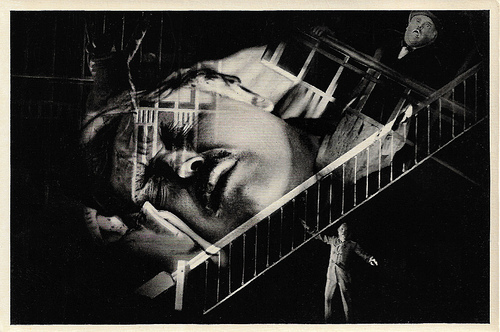
Werner Krauss in Geheimnisse einer Seele (1926). German collectors card by Ross Verlag for the album Vom Werden deutscher Filmkunst. Teil I. Der stumme Film (Cigaretten-Bilderdienst Altona-Bahrenfeld 1935), no. 165. Photo: Ufa. Publicity still for Geheimnisse einer Seele/Secrets of a Soul (G.W. Pabst, 1926).
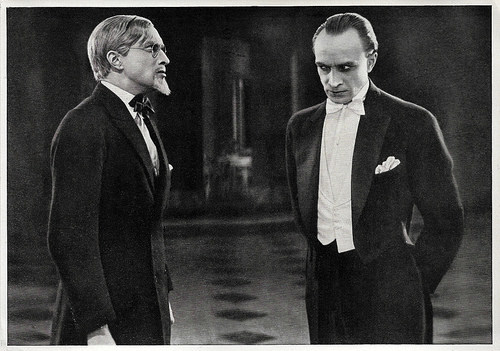
Conrad Veidt in Die Brüder Schellenberg (1926). German collectors card by Ross Verlag in the series Vom Werden deutscher Filmkunst - Der Stumme Film, picture no. 165, group 40. Photo: Ufa. Publicity still for Die Brüder Schellenberg/The Brothers Schellenberg/ (Karl Grune, 1926). Caption: Conrad Veidt in his double role in the film 'Die Brüder Schellenberg'.
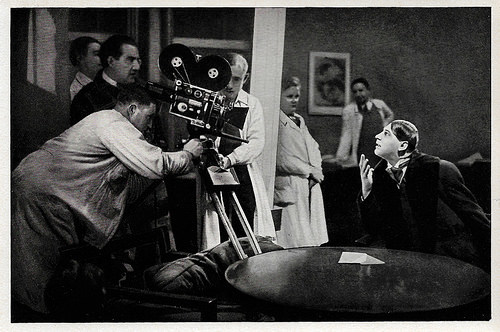
Fritz Rasp at the set of Frau im Mond (1929). German collectors card by Ross Verlag in the series Vom Werden deutscher Filmkunst - Der Stumme Film, picture no. 169, group 43. Photo: Ufa. Set photo of Frau im Mond/Woman in the Moon (1929) directed by Fritz Lang.
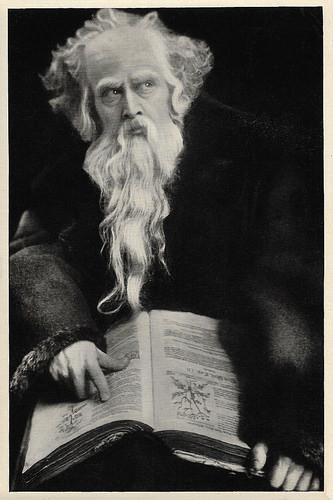
Gösta Ekman in Faust, Eine deutsche Volkssage (1926). German collectors card by Ross Verlag in the series Vom Werden deutscher Filmkunst - Der Stumme Film, picture no. 171. Photo: Ufa. Publicity still with Gösta Ekman as the old Faust in Faust, Eine deutsche Volkssage/Faust (Friedrich Wilhelm Murnau, 1926).
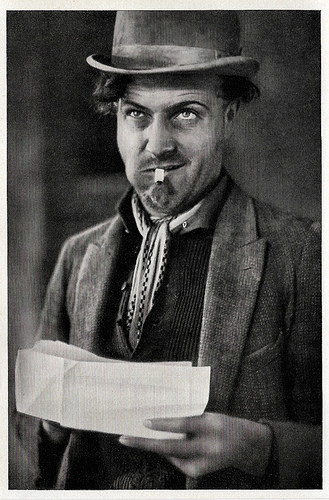
Willy Fritsch in Spione (1928). German collectors card by Ross Verlag in the series Vom Werden deutscher Filmkunst - Der Stumme Film, picture, no, 173, group 43. Photo: Ufa. Publicity still for Spione/Spies (Fritz Lang, 1928).
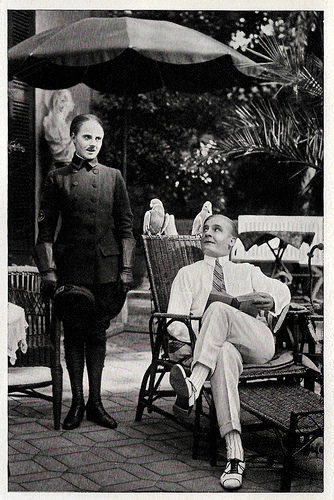
Ossi Oswalda and Rudolf Forster in Amor am Steuer (1921). German collectors card by Ross Verlag in the series Vom Werden deutscher Filmkunst - Der Stumme Film, picture no. 176, group 43. Photo: Ossi Oswalda-Film. Caption: Ossi Oswalda as chauffeur and Rudolf Forster in Amor am Steuer (Victor Janson, 1921).
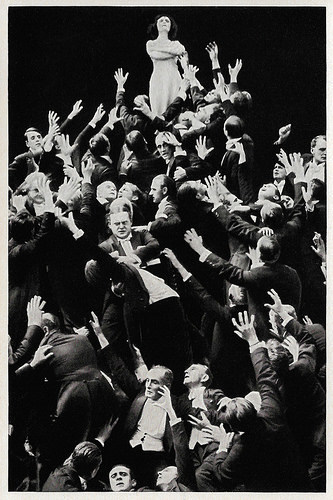
Pola Negri in Sappho (1921). German collectors card by Ross Verlag in the series Vom Werden Deutscher Filmkunst - Der Stumme Film, picture no. 179, group 43. Photo: Union-Film. Publicity still for Sappho/Mad Love (Dimitri Buchowetzki, 1921). Caption: Artistically composed mass scene from the film Sappho/Mad Love, with Pola Negri at the top of a human pyramid.
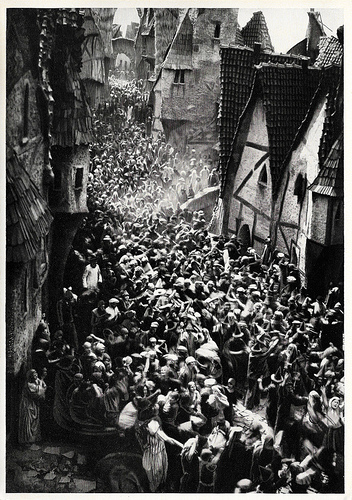
Scene from Der Golem, wie er in die Welt kam (1920). German collectors card by Ross Verlag in the series Vom Werden deutscher Filmkunst - Der Stumme Film, picture no. 180, group 40. Photo: Ufa. Publicity still for Der Golem, wie er in die Welt kam/The Golem: How He Came Into the World (Carl Boese, Paul Wegener, 1920).
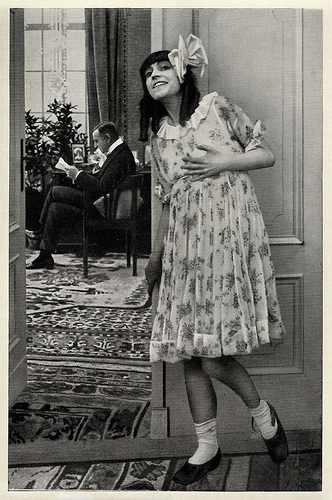
Asta Nielsen in Engelein (1914). German collectors card for the album by Dr. Oskar Kalbus, Vom Werden deutscher Filmkunst, Vol. I, Der Stummfilm (Cigaretten Bilderdienst, 1935). Photo: PAGU. Asta Nielsen in Engelein (Urban Gad, 1914).
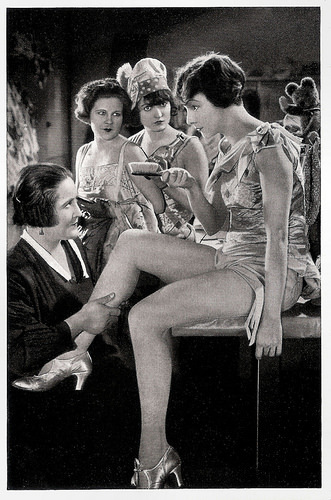
Dina Gralla in Das Girl von der Revue (1928). German collectors card by Ross Verlag in the series Vom Werden deutscher Filmkunst - Der Stumme Film, picture no. 184, group 43. Photo: Ufa. Publicity still for Das Girl von der Revue/The Girl from the Revue (Richard Eichberg, 1928).
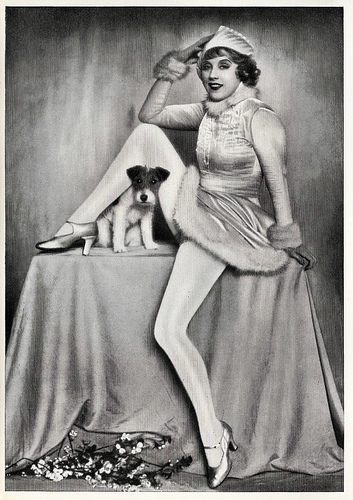
Anny Ondra . German collectors card by Ross Verlag in the series Vom Werden deutscher Filmkunst - Der Stumme Film, picture no. 186, group 40. Photo: Balázs.
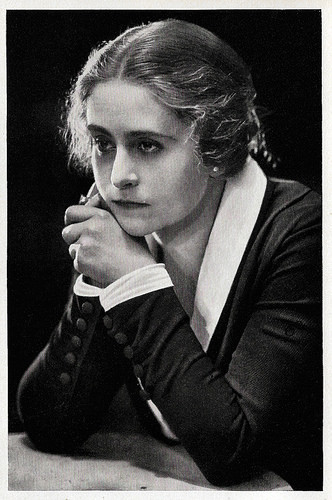
Carola Toelle in Die Schuld de Grafen Weronski (1921). German collectors card by Ross Verlag in the series Vom Werden deutscher Filmkunst - Der Stumme Film, picture no. 69, group 39. Photo: D.L.S. Publicity still for Die Schuld des Grafen Weronski/The debt of Count Weronski (Rudolf Biebrach, 1921).
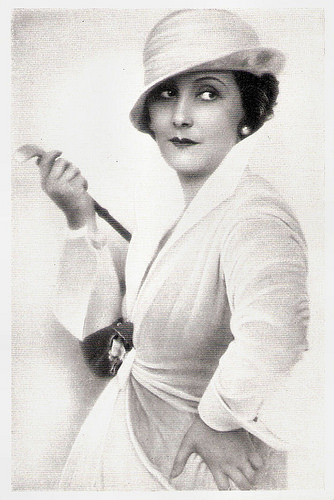
Lil Dagover in Ungarische Rhapsodie (1928). German collectors card by Ross Verlag for the album Vom Werden deutscher Filmkunst. Teil I. Der stumme Film (Cigaretten-Bilderdienst Altona-Bahrenfeld 1935), picture no. 189, group 41. Photo: Ufa. Publicity still for Ungarische Rhapsodie/Hungarian Rhapsody (Hanns Schwarz, 1928).
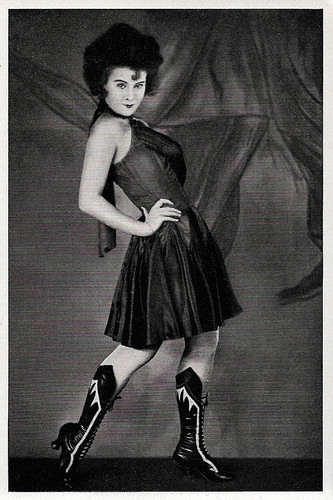
Lilian Harvey in Vater werden ist nicht schwer... (1926). German collectors card by Ross Verlag in the series Vom Werden Deutscher Filmkunst - Der Stumme Film, picture no. 192, Group 43. Photo: Ufa. Publicity still for Vater werden ist nicht schwer.../It's Easy to Become a Father (Erich Schönfelder, 1926).
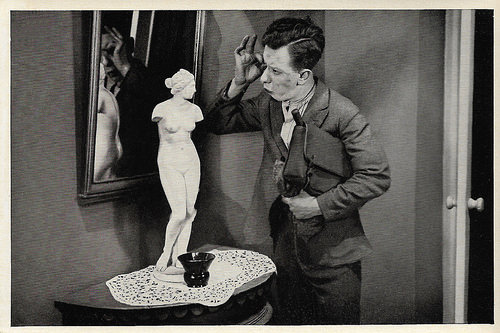
Gerhard Ritterband in Der Tanzstudent (1928). German collectors card by Ross Verlag in the series Vom Werden Deutscher Filmkunst - Der Stumme Film, picture no. 193. Photo: Ufa. Publicity still for Der Tanzstudent/Because I Love You (Johannes Guter, 1928).
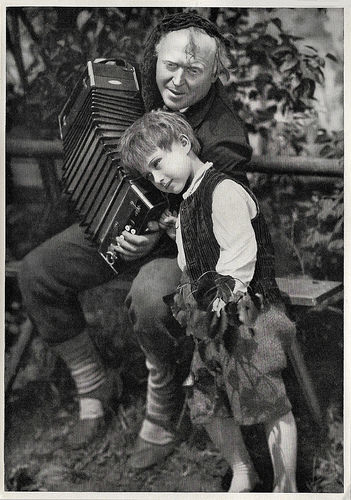
Werner Krauss and Heinerle in Der fidele Bauer (1929). German collectors card by Ross Verlag in the series Vom Werden deutscher Filmkunst - Der Stumme Film, picture no. 194, group 40. Photo: Ufa. Publicity still for Der fidele Bauer/The Merry Farmer (Franz Seitz, 1929).
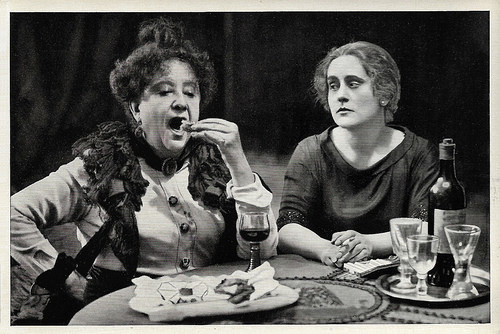
Adele Sandrock and Carola Toelle in Die Schuld des Grafen Weronski (1921). German collectors card by Ross Verlag in the series Vom Werden deutscher Filmkunst - Der Stumme Film, picture no. 197. Photo: Maxim-Film. Publicity still for Die Schuld des Grafen Weronski/The debt of Count Weronski (Rudolf Biebrach, 1921).
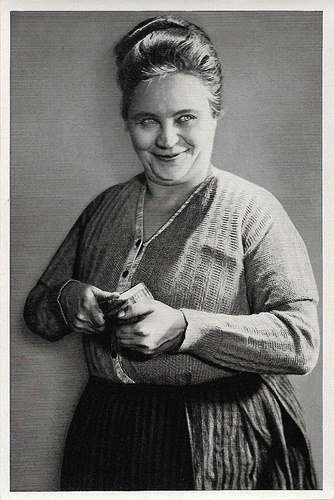
Margarete Kupfer in Zuflucht (1928). German collectors card by Ross Verlag in the series Vom Werden deutscher Filmkunst - Der Stumme Film, picture no. 198, group 43. Photo: Henny Porten-Film. Publicity still for Zuflucht/Refuge (Carl Froelich, 1928).
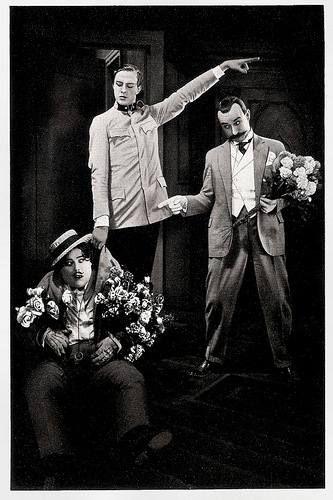
Werner Fuetterer and Hans Junkermann in Durchlaucht Radieschen (1927). German collectors card by Ross Verlag in the series Vom Werden deutscher Filmkunst - Der Stumme Film, picture no. 199, group 43. Photo: Eichberg-Film. Publicity still for Durchlaucht Radieschen/Highness Radish (Richard Eichberg, 1927).
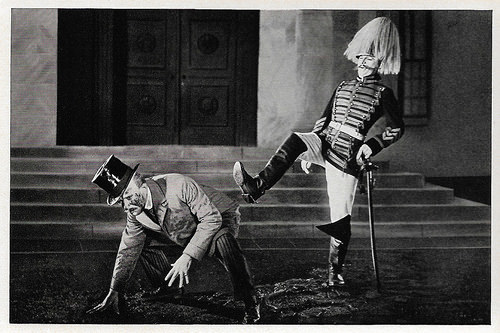
Die selige Exzellenz (1927). German collectors card by Ross Verlag in the series Vom Werden deutscher Filmkunst - Der Stumme Film, picture no. 200, group 43. Photo: Ufa. Publicity still for Die selige Exzellenz/His Late Excellency (Adolf E. Licho, Wilhelm Thiele, 1927).
This was the last post on Vom Werden deutscher Filmkunst.

Werner Krauss in Geheimnisse einer Seele (1926). German collectors card by Ross Verlag for the album Vom Werden deutscher Filmkunst. Teil I. Der stumme Film (Cigaretten-Bilderdienst Altona-Bahrenfeld 1935), no. 165. Photo: Ufa. Publicity still for Geheimnisse einer Seele/Secrets of a Soul (G.W. Pabst, 1926).

Conrad Veidt in Die Brüder Schellenberg (1926). German collectors card by Ross Verlag in the series Vom Werden deutscher Filmkunst - Der Stumme Film, picture no. 165, group 40. Photo: Ufa. Publicity still for Die Brüder Schellenberg/The Brothers Schellenberg/ (Karl Grune, 1926). Caption: Conrad Veidt in his double role in the film 'Die Brüder Schellenberg'.

Fritz Rasp at the set of Frau im Mond (1929). German collectors card by Ross Verlag in the series Vom Werden deutscher Filmkunst - Der Stumme Film, picture no. 169, group 43. Photo: Ufa. Set photo of Frau im Mond/Woman in the Moon (1929) directed by Fritz Lang.

Gösta Ekman in Faust, Eine deutsche Volkssage (1926). German collectors card by Ross Verlag in the series Vom Werden deutscher Filmkunst - Der Stumme Film, picture no. 171. Photo: Ufa. Publicity still with Gösta Ekman as the old Faust in Faust, Eine deutsche Volkssage/Faust (Friedrich Wilhelm Murnau, 1926).

Willy Fritsch in Spione (1928). German collectors card by Ross Verlag in the series Vom Werden deutscher Filmkunst - Der Stumme Film, picture, no, 173, group 43. Photo: Ufa. Publicity still for Spione/Spies (Fritz Lang, 1928).

Ossi Oswalda and Rudolf Forster in Amor am Steuer (1921). German collectors card by Ross Verlag in the series Vom Werden deutscher Filmkunst - Der Stumme Film, picture no. 176, group 43. Photo: Ossi Oswalda-Film. Caption: Ossi Oswalda as chauffeur and Rudolf Forster in Amor am Steuer (Victor Janson, 1921).

Pola Negri in Sappho (1921). German collectors card by Ross Verlag in the series Vom Werden Deutscher Filmkunst - Der Stumme Film, picture no. 179, group 43. Photo: Union-Film. Publicity still for Sappho/Mad Love (Dimitri Buchowetzki, 1921). Caption: Artistically composed mass scene from the film Sappho/Mad Love, with Pola Negri at the top of a human pyramid.

Scene from Der Golem, wie er in die Welt kam (1920). German collectors card by Ross Verlag in the series Vom Werden deutscher Filmkunst - Der Stumme Film, picture no. 180, group 40. Photo: Ufa. Publicity still for Der Golem, wie er in die Welt kam/The Golem: How He Came Into the World (Carl Boese, Paul Wegener, 1920).

Asta Nielsen in Engelein (1914). German collectors card for the album by Dr. Oskar Kalbus, Vom Werden deutscher Filmkunst, Vol. I, Der Stummfilm (Cigaretten Bilderdienst, 1935). Photo: PAGU. Asta Nielsen in Engelein (Urban Gad, 1914).

Dina Gralla in Das Girl von der Revue (1928). German collectors card by Ross Verlag in the series Vom Werden deutscher Filmkunst - Der Stumme Film, picture no. 184, group 43. Photo: Ufa. Publicity still for Das Girl von der Revue/The Girl from the Revue (Richard Eichberg, 1928).

Anny Ondra . German collectors card by Ross Verlag in the series Vom Werden deutscher Filmkunst - Der Stumme Film, picture no. 186, group 40. Photo: Balázs.

Carola Toelle in Die Schuld de Grafen Weronski (1921). German collectors card by Ross Verlag in the series Vom Werden deutscher Filmkunst - Der Stumme Film, picture no. 69, group 39. Photo: D.L.S. Publicity still for Die Schuld des Grafen Weronski/The debt of Count Weronski (Rudolf Biebrach, 1921).

Lil Dagover in Ungarische Rhapsodie (1928). German collectors card by Ross Verlag for the album Vom Werden deutscher Filmkunst. Teil I. Der stumme Film (Cigaretten-Bilderdienst Altona-Bahrenfeld 1935), picture no. 189, group 41. Photo: Ufa. Publicity still for Ungarische Rhapsodie/Hungarian Rhapsody (Hanns Schwarz, 1928).

Lilian Harvey in Vater werden ist nicht schwer... (1926). German collectors card by Ross Verlag in the series Vom Werden Deutscher Filmkunst - Der Stumme Film, picture no. 192, Group 43. Photo: Ufa. Publicity still for Vater werden ist nicht schwer.../It's Easy to Become a Father (Erich Schönfelder, 1926).

Gerhard Ritterband in Der Tanzstudent (1928). German collectors card by Ross Verlag in the series Vom Werden Deutscher Filmkunst - Der Stumme Film, picture no. 193. Photo: Ufa. Publicity still for Der Tanzstudent/Because I Love You (Johannes Guter, 1928).

Werner Krauss and Heinerle in Der fidele Bauer (1929). German collectors card by Ross Verlag in the series Vom Werden deutscher Filmkunst - Der Stumme Film, picture no. 194, group 40. Photo: Ufa. Publicity still for Der fidele Bauer/The Merry Farmer (Franz Seitz, 1929).

Adele Sandrock and Carola Toelle in Die Schuld des Grafen Weronski (1921). German collectors card by Ross Verlag in the series Vom Werden deutscher Filmkunst - Der Stumme Film, picture no. 197. Photo: Maxim-Film. Publicity still for Die Schuld des Grafen Weronski/The debt of Count Weronski (Rudolf Biebrach, 1921).

Margarete Kupfer in Zuflucht (1928). German collectors card by Ross Verlag in the series Vom Werden deutscher Filmkunst - Der Stumme Film, picture no. 198, group 43. Photo: Henny Porten-Film. Publicity still for Zuflucht/Refuge (Carl Froelich, 1928).

Werner Fuetterer and Hans Junkermann in Durchlaucht Radieschen (1927). German collectors card by Ross Verlag in the series Vom Werden deutscher Filmkunst - Der Stumme Film, picture no. 199, group 43. Photo: Eichberg-Film. Publicity still for Durchlaucht Radieschen/Highness Radish (Richard Eichberg, 1927).

Die selige Exzellenz (1927). German collectors card by Ross Verlag in the series Vom Werden deutscher Filmkunst - Der Stumme Film, picture no. 200, group 43. Photo: Ufa. Publicity still for Die selige Exzellenz/His Late Excellency (Adolf E. Licho, Wilhelm Thiele, 1927).
This was the last post on Vom Werden deutscher Filmkunst.
Published on September 08, 2017 22:00
September 7, 2017
Isobel Elsom
Isobel Elsom (1893-1981) was an English screen, stage and television actress. She usually was cast as an aristocratic lady of the upper class. Elsom was directed in nine British silent films by her husband Maurice Elvey and frequently co-starred with Owen Nares. Later she worked with such directors as Charles Chaplin and Alfred Hitchcock.
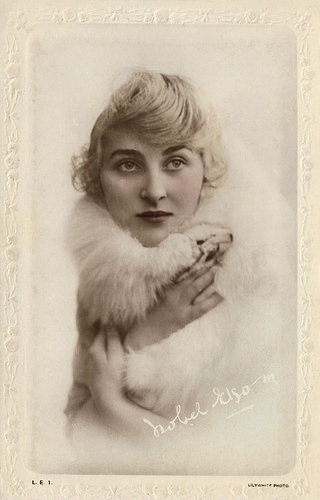
British postcard in the Lilywhite Photographic series, no. L.E. 1.
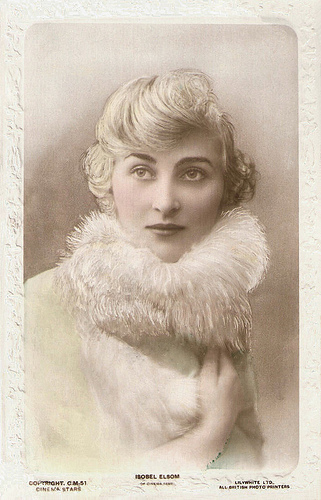
British postcard in the Lilywhite Photographic series, Cinema Stars, no. CM 51.
Wealthy murder victim
Isobel Elsom was born Isabelle Jeannette Reed in Chesterton, Cambridge, in 1893. She attended Howard College, Bedford England.
Over the course of three decades she appeared in 17 Broadway productions, beginning with The Ghost Train in 1926. In the late 1930s she settled in America.
Her best-known stage role was the wealthy murder victim in Ladies in Retirement (1939), a role she repeated in the 1941 film version. Her other theatre credits included The Innocents and Romeo and Juliet.
Elsom made her first screen appearance during the silent film era and appeared in nearly 100 films throughout her career. She often co-starred with Owen Nares in such romances as Onward Christian Soldiers (Rex Wilson, 1918).
Elsom met her first husband, director Maurice Elvey, when he cast her in his film Quinneys (Maurice Elvey, 1919). They married in 1923. He went on to direct her in eight more films before they divorced.
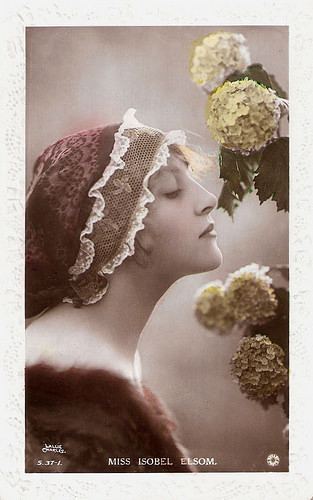
British postcard by Rotary Photo, London, no. 5.37-1. Photo: Lallie Charles.
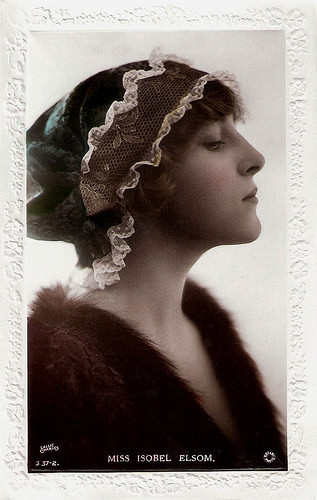
British postcard by Rotary Photo, London, no. 5.37-2. Photo: Lallie Charles.
The epitome of opulent, grande dame haughtiness
According to Gary Brumburgh at IMDb , Isobel Elsom was 'the epitome of opulent, grande dame haughtiness'. "What the tiny-framed Elsom lacked in stature, she certainly made up for in pure chutzpah. The matronly actress remained in Hollywood and played a number of huffy bluebloods in both comedies and drama for over two decades, often as a minor Margaret Dumont-like foil".
Her sound film credits include The White Cliffs of Dover (Clarence Brown, 1944), The Unseen (Lewis Allen, 1945), Of Human Bondage (Edmund Goulding, 1946), the fantasy / romantic comedy-drama The Ghost and Mrs. Muir (Joseph L. Mankiewicz, 1947), Monsieur Verdoux (Charles Chaplin, 1947), The Paradine Case (Alfred Hitchcock, 1947), and The Two Mrs. Carrolls (Peter Godfrey, 1947) with Humphrey Bogart.
Her later films included Love Is a Many-Splendored Thing (Henry King, 1955), the Vincent van Gogh biopic Lust for Life (Vincente Minnelli, 1956) starring Kirk Douglas , and 23 Paces to Baker Street (Henry Hathaway, 1956).
Her final films included The Pleasure Seekers (Jean Negulesco, 1964) with Ann-Margret , and the successful musical My Fair Lady (George Cukor, 1964) featuring Audrey Hepburn . Elsom also appeared opposite Jerry Lewis in four of his late 1950s and early 1960s solo films.
Elsom's television credits included Alfred Hitchcock Presents (1956-1957, 1962-1963, at least 4 appearances), Hawaiian Eye (1961-1962), Dr. Kildare (1963-1964) and My Three Sons (1965).
Elsom's second husband was actor Carl Harbord, from 1942 until his death in 1958. Sometimes she was billed as Isobel Harbord. She had no children. In 1981, Isobel Elsom died in Woodland Hills, California, aged 87.
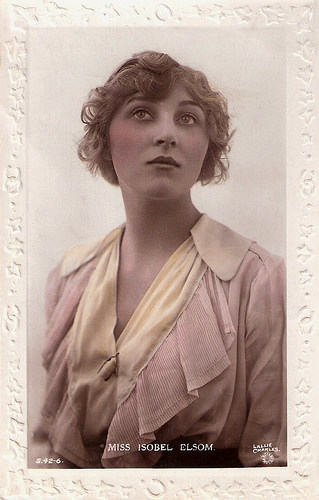
British postcard by Rotary Photo, London, no. 5.42-6. Photo: Lallie Charles.
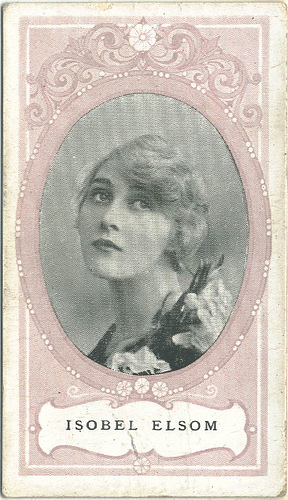
British cigarette card by Wills' Scissors Cigarettes, no. 8. Collection: Manuel Palomino Arjona @ Flickr.
Sources: (IMDb), Wikipedia and .

British postcard in the Lilywhite Photographic series, no. L.E. 1.

British postcard in the Lilywhite Photographic series, Cinema Stars, no. CM 51.
Wealthy murder victim
Isobel Elsom was born Isabelle Jeannette Reed in Chesterton, Cambridge, in 1893. She attended Howard College, Bedford England.
Over the course of three decades she appeared in 17 Broadway productions, beginning with The Ghost Train in 1926. In the late 1930s she settled in America.
Her best-known stage role was the wealthy murder victim in Ladies in Retirement (1939), a role she repeated in the 1941 film version. Her other theatre credits included The Innocents and Romeo and Juliet.
Elsom made her first screen appearance during the silent film era and appeared in nearly 100 films throughout her career. She often co-starred with Owen Nares in such romances as Onward Christian Soldiers (Rex Wilson, 1918).
Elsom met her first husband, director Maurice Elvey, when he cast her in his film Quinneys (Maurice Elvey, 1919). They married in 1923. He went on to direct her in eight more films before they divorced.

British postcard by Rotary Photo, London, no. 5.37-1. Photo: Lallie Charles.

British postcard by Rotary Photo, London, no. 5.37-2. Photo: Lallie Charles.
The epitome of opulent, grande dame haughtiness
According to Gary Brumburgh at IMDb , Isobel Elsom was 'the epitome of opulent, grande dame haughtiness'. "What the tiny-framed Elsom lacked in stature, she certainly made up for in pure chutzpah. The matronly actress remained in Hollywood and played a number of huffy bluebloods in both comedies and drama for over two decades, often as a minor Margaret Dumont-like foil".
Her sound film credits include The White Cliffs of Dover (Clarence Brown, 1944), The Unseen (Lewis Allen, 1945), Of Human Bondage (Edmund Goulding, 1946), the fantasy / romantic comedy-drama The Ghost and Mrs. Muir (Joseph L. Mankiewicz, 1947), Monsieur Verdoux (Charles Chaplin, 1947), The Paradine Case (Alfred Hitchcock, 1947), and The Two Mrs. Carrolls (Peter Godfrey, 1947) with Humphrey Bogart.
Her later films included Love Is a Many-Splendored Thing (Henry King, 1955), the Vincent van Gogh biopic Lust for Life (Vincente Minnelli, 1956) starring Kirk Douglas , and 23 Paces to Baker Street (Henry Hathaway, 1956).
Her final films included The Pleasure Seekers (Jean Negulesco, 1964) with Ann-Margret , and the successful musical My Fair Lady (George Cukor, 1964) featuring Audrey Hepburn . Elsom also appeared opposite Jerry Lewis in four of his late 1950s and early 1960s solo films.
Elsom's television credits included Alfred Hitchcock Presents (1956-1957, 1962-1963, at least 4 appearances), Hawaiian Eye (1961-1962), Dr. Kildare (1963-1964) and My Three Sons (1965).
Elsom's second husband was actor Carl Harbord, from 1942 until his death in 1958. Sometimes she was billed as Isobel Harbord. She had no children. In 1981, Isobel Elsom died in Woodland Hills, California, aged 87.

British postcard by Rotary Photo, London, no. 5.42-6. Photo: Lallie Charles.

British cigarette card by Wills' Scissors Cigarettes, no. 8. Collection: Manuel Palomino Arjona @ Flickr.
Sources: (IMDb), Wikipedia and .
Published on September 07, 2017 22:00
September 6, 2017
Triboulet (1923)
Triboulet (1923) is an Italian period piece directed by actor Febo Mari for the Società Italiana Cines and the UCI. Achille Vitti played King Francis I of France, Umberto Zanuccoli played the title role, the historical jester of kings Louis XII and Francis I of France, and Elena Sangro played Giletta. G.B. Falci in Milano was the publisher of this series of black and white postcards for the film.
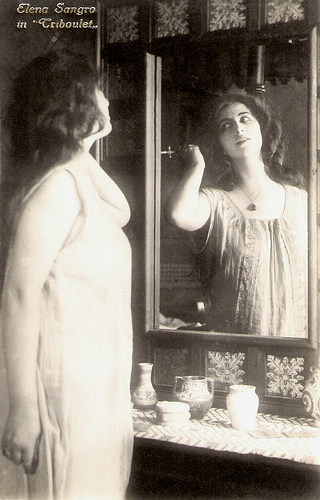
Elena Sangro. Italian postcard by G.B. Falci, Milano. Photo: Cines/UCI. Publicity still for Triboulet (Febo Mari, 1923)
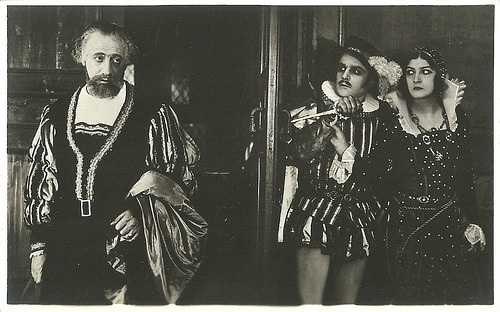
Italian postcard by G.B. Falci, Milano. Photo: Cines/UCI. Publicity still for Triboulet (Febo Mari, 1923), 3th and 4th episode.
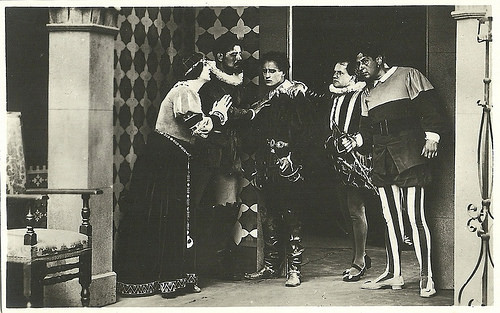
Italian postcard by G.B. Falci, Milano. Photo: Cines/UCI. Publicity still for Triboulet (Febo Mari, 1923), 3th and 4th episode.
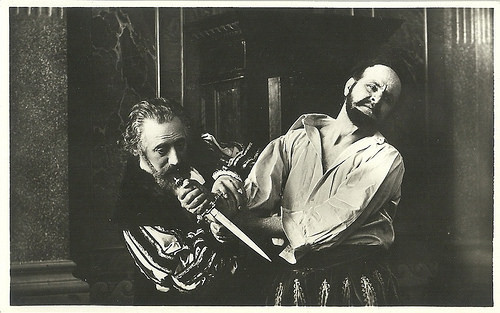
Italian postcard by G.B. Falci, Milano. Photo: Cines/UCI. Publicity still for Triboulet (Febo Mari, 1923), 3th and 4th episode.
Delirium of Love
Triboulet (1923) by Febo Mari was originally released as a six part serial, then reduced to a three-part serial, and finally just one single feature film of 2.500 metres. The six episodes were titled: 1) The King's Buffoon, 2) The King of the Misers, 3) The Mysteries of the Louvre, 4) The Cour des Miracles, 5) The Revenge of the Nameless, and 6) Delirium of Love.
The film was based on the novel of the same title (prob. 1910) by Michele Zevaco. Triboulet (1479–1536) was a historical figure, a jester of kings Louis XII and Francis I of France. He appears in Book 3 of François Rabelais' Pantagrueline chronicles. He also appears in Victor Hugo's Le Roi s'amuse and its opera version, Giuseppe Verdi's Rigoletto, a blend of 'Triboulet' and French rigoler (to laugh), intended to deflect the censorship that Hugo's work had received.
After the defeat of Pavia, king Francesco (or Francis I) (Achille Vitti) dedicates himself to peace, though not disdaining from his notorious love life. At the age of 50 he is tired of Mme de Ferron ('la belle Ferronière'), and gets interested in young Gillette ( Elena Sangro ).
Gilette is an orphan raised by Triboulet (Umberto Zanuccoli), the king's buffoon, but in reality he is a nobleman called Ferrial. Gillette loves Manfred (Giovanni Schettini), the king of the Cour des Miracles (the Paris slums). Manfred saves Gillette from the clutches of Francis. Francis is in reality Gilette's father by a former mistress, Margentina (Tina Ceccaci Renaldi), now a mad and visionary woman.
Hurt in one of his actions, Manfred is saved and cured by an Italian couple, who travel with their servant Spadacappa. While in bed, immobilised, Gillette is abducted and locked up in a convent. Barely healed, Manfred descends the Louvre to free her. The palace takes fire and the king is lucky to escape save and sound. Other adventures follow, in which Manfred discovers the Italian couple are his parents, who have come to France to find him.
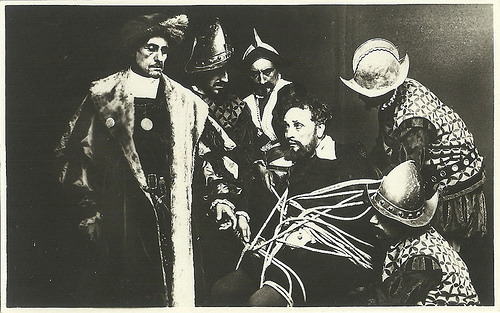
Italian postcard by G.B. Falci, Milano. Photo: Cines/UCI. Publicity still for Triboulet (Febo Mari, 1923).
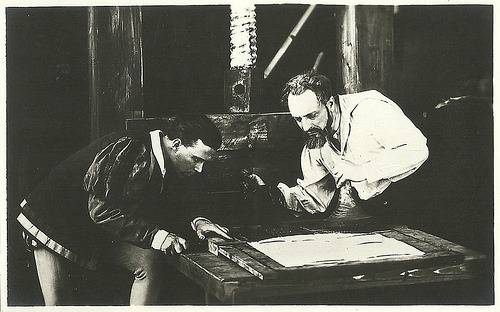
Italian postcard by G.B. Falci, Milano. Photo: Cines/UCI. Publicity still for Triboulet (Febo Mari, 1923).
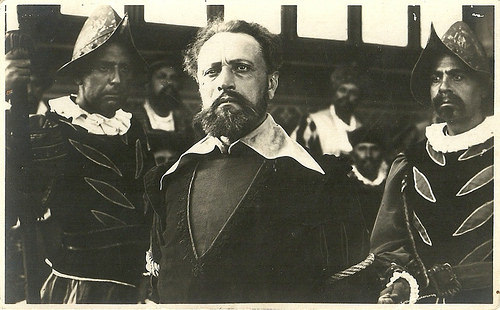
Italian postcard by G.B. Falci, Milano. Photo: Cines/UCI. Publicity still for Triboulet (Febo Mari, 1923), 5th and 6th episode.
Sources: Vittorio Martinelli (Il cinema muto italiano, 1923-1931 - Italian), Wikipedia and IMDb.

Elena Sangro. Italian postcard by G.B. Falci, Milano. Photo: Cines/UCI. Publicity still for Triboulet (Febo Mari, 1923)

Italian postcard by G.B. Falci, Milano. Photo: Cines/UCI. Publicity still for Triboulet (Febo Mari, 1923), 3th and 4th episode.

Italian postcard by G.B. Falci, Milano. Photo: Cines/UCI. Publicity still for Triboulet (Febo Mari, 1923), 3th and 4th episode.

Italian postcard by G.B. Falci, Milano. Photo: Cines/UCI. Publicity still for Triboulet (Febo Mari, 1923), 3th and 4th episode.
Delirium of Love
Triboulet (1923) by Febo Mari was originally released as a six part serial, then reduced to a three-part serial, and finally just one single feature film of 2.500 metres. The six episodes were titled: 1) The King's Buffoon, 2) The King of the Misers, 3) The Mysteries of the Louvre, 4) The Cour des Miracles, 5) The Revenge of the Nameless, and 6) Delirium of Love.
The film was based on the novel of the same title (prob. 1910) by Michele Zevaco. Triboulet (1479–1536) was a historical figure, a jester of kings Louis XII and Francis I of France. He appears in Book 3 of François Rabelais' Pantagrueline chronicles. He also appears in Victor Hugo's Le Roi s'amuse and its opera version, Giuseppe Verdi's Rigoletto, a blend of 'Triboulet' and French rigoler (to laugh), intended to deflect the censorship that Hugo's work had received.
After the defeat of Pavia, king Francesco (or Francis I) (Achille Vitti) dedicates himself to peace, though not disdaining from his notorious love life. At the age of 50 he is tired of Mme de Ferron ('la belle Ferronière'), and gets interested in young Gillette ( Elena Sangro ).
Gilette is an orphan raised by Triboulet (Umberto Zanuccoli), the king's buffoon, but in reality he is a nobleman called Ferrial. Gillette loves Manfred (Giovanni Schettini), the king of the Cour des Miracles (the Paris slums). Manfred saves Gillette from the clutches of Francis. Francis is in reality Gilette's father by a former mistress, Margentina (Tina Ceccaci Renaldi), now a mad and visionary woman.
Hurt in one of his actions, Manfred is saved and cured by an Italian couple, who travel with their servant Spadacappa. While in bed, immobilised, Gillette is abducted and locked up in a convent. Barely healed, Manfred descends the Louvre to free her. The palace takes fire and the king is lucky to escape save and sound. Other adventures follow, in which Manfred discovers the Italian couple are his parents, who have come to France to find him.

Italian postcard by G.B. Falci, Milano. Photo: Cines/UCI. Publicity still for Triboulet (Febo Mari, 1923).

Italian postcard by G.B. Falci, Milano. Photo: Cines/UCI. Publicity still for Triboulet (Febo Mari, 1923).

Italian postcard by G.B. Falci, Milano. Photo: Cines/UCI. Publicity still for Triboulet (Febo Mari, 1923), 5th and 6th episode.
Sources: Vittorio Martinelli (Il cinema muto italiano, 1923-1931 - Italian), Wikipedia and IMDb.
Published on September 06, 2017 22:00
September 5, 2017
Blanche Montel
Blanche Montel (1902-1998) was a French actress who had a long career in French silent and sound cinema between the 1910s to the 1940s.
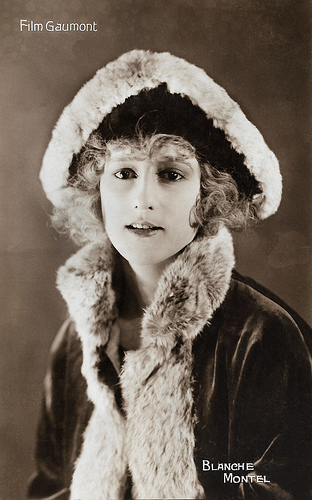
French postcard. Photo: Film Gaumont.
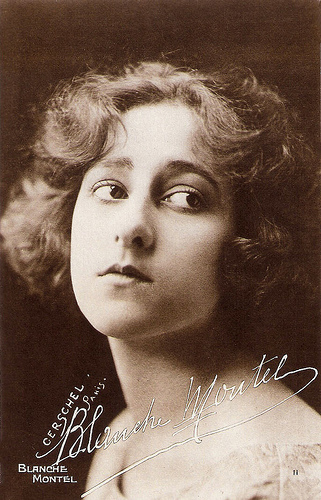
French postcard by Cinémagazine, no. 11. Photo: Gerschell, Paris.
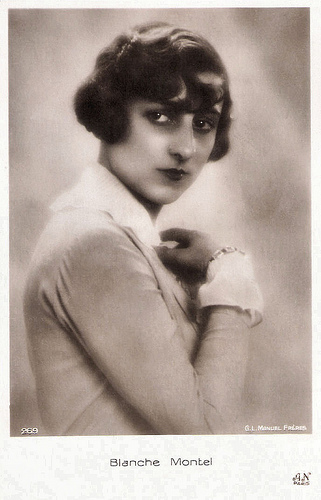
French postcard by A.N., Paris, no. 269. Photo: G.L. Manuel Frères.
Sensibility, Seductiveness and Freshness
Rose Blanche Jeanne Montel was born in Tours, France in 1902. When she was only 11, she was already engaged by filmmaker Alfred Machin to play a young Dutch girl, Kaatje, in La fille de Delft/A Tragedy in the Clouds (Alfred Machin, 1914). The film was shot at the Belgium Pathé studio of Chateau Karreveld at Molenbeek-Saint-Jean near Brussels.
Montel then worked in scenography until she met Gaumont film director Louis Feuillade, who was impressed by her sensibility, her seductiveness and her freshness. He directed her in various short films but also in long running serials like Barrabas (1919) with Édouard Mathé , Les deux gamines/The Two Girls (1921), and L'orpheline/The orphan (1921), often starring Sandra Milovanoff.
From the early 1920s on, Montel had leading parts in La fille des chiffoniers/The Girl of the Dust Bin (Henri Desfontaines, 1922), Son altesse/Her Higness (Henri Desfontaines, 1923), and Une vieille marquise très riche/An old very rich marchioness (Emilien Champetier, 1923).
It was followed by L'éveilleur d'instincts/The awakening of instincts(Emilien Champetier, 1925) with Armand Bernard , La vocation d'André Carel/The Vocation of André Carel (Jean Choux, 1925) with Michel Simon , Le roi de la pédale/King of the pedal (Maurice Champreux, 1925), and her last silent film La ronde infernale/The infernal round (Luitz-Morat, 1928) starring Jean Angelo .
Montel's first sound film was L'Arlésienne (Jacques de Baroncelli, 1930) and she remained quite active in the early 1930s in films such as the comedy Flagrant délit/Flagrante delicto (Hanns Schwarz, George Tréville, 1931), Clair de lune/Moonlight (Henri Diamant-Berger, 1932) with Henri Garat , and the drama L'enfant du miracle/The Miracle Child (D.B. Maurice, 1932).
Then followed parts in Miquette et sa mère/Miquette and Her Mother (Diamant-Berger, 1933) with Montel as Miquette, Les bleus du ciel/The Blue Ones of the Sky (Henri Decoin, 1933) with Albert Préjean, and La maison du mystère/The house of the mystery (Gaston Roudès, 1933).
In Les trois mousquetaires/The Three Musketeers (Henri Diamant-Berger, 1933, she played Constance opposite Aimé Simon-Girard as D'Artganan. Other films were L'aventurier/The Adventurer (Marcel L'Herbier, 1934) starring Victor Francen , and Durand bijoutier/Durand Jeweller (Jean Stelli, 1938). In addition to these films Montel played smaller roles in various French films of the 1920s and 1930s. In those two decades she was also an acclaimed stage actress.
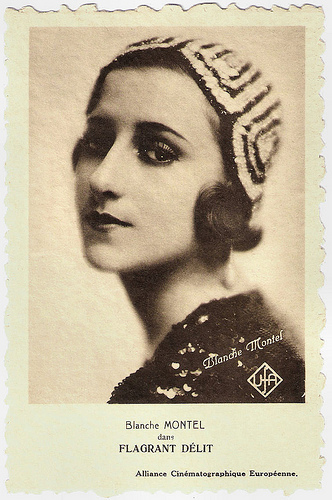
Belgian postcard by Nels / Ern. Thill, Bruxelles / Alliance Cinematographiques Européenne. Photo: Ufa. Publicity still for Flagrant Délit (Hanns Schwarz, Georges Tréville, 1931). Flagrant Délit was an alternate-language version of Einbrecher/Burglars (Hanns Schwarz, 1930) with Lilian Harvey and Willy Fritsch .
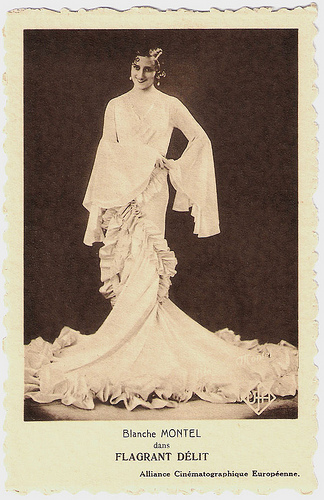
French postcard by Nels / Alliance Cinématographiques Européenne. Photo: Ufa. Publicity still for Flagrant Délit (Hanns Schwarz, Georges Tréville, 1931).
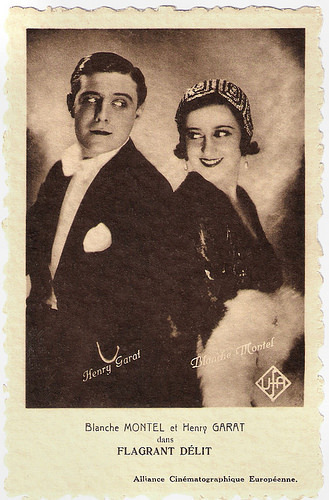
French postcard by Nels / Alliance Cinématographiques Européenne. Photo: Ufa. Publicity still with Blanche Montel and Henri Garat in Flagrant Délit (Hanns Schwarz, Georges Tréville, 1931).
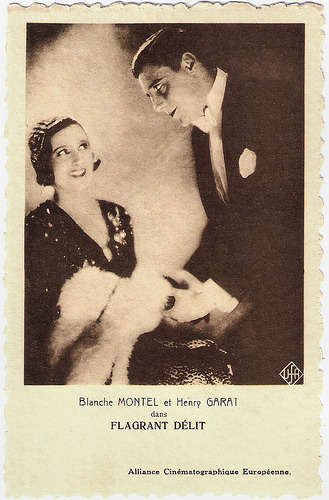
French postcard by Nels / Alliance Cinématographiques Européenne. Photo: Ufa. Publicity still with Blanche Montel and Henri Garat in Flagrant Délit (Hanns Schwarz, Georges Tréville, 1931).
The Beautiful Nivernaise
A highlight among her silent films was La belle Nivernaise/The Beauty from Nivernais (Jean Epstein, 1924).I
n the documentary series Cinema Europe: The Other Hollywood (1995), Kevin Brownlow and David Gill interviewed Blanche Montel. She tells ironically how surprised she was, that after she was asked to play the female lead in La belle Nivernaise, she found out that the Nivernaise was not a beautiful young girl but a very old and ugly boat.
This quite naturalist film on life aboard a barge precedes Jean Vigo's better known L' Atalante.
Between 1927 and 1934 Montel was married to film director Henri Decoin, but she did not play in many of his films.
In the early 1930s she played more often in films by Henri Diamant-Berger. Montel and Decoin had one son, Jacques (1928-1998). After she had divorced Henri Decoin she had an affair with Jean-Pierre Aumont , until 1940 when Aumont fled to the United States.
Blanche Montel's last performance was that of Madame Brown in a film by her ex-husband, L' Homme de Londres/The London Man (Henri Decoin, 1943), a Georges Simenon adaptation. In 1946 she started a new career as an impresario for artists.
After her son Jacques died in 1998, Blanche Montel soon also passed away in 1999 in Luzarches, at the high age of 95.
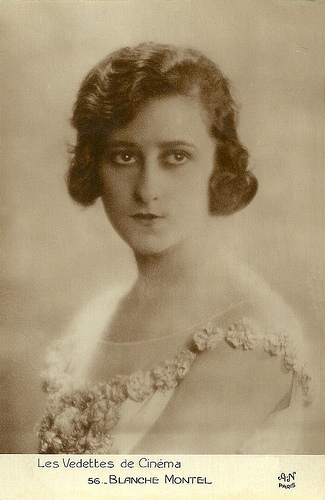
French postcard by A.N., Paris, in the series Les Vedettes de Cinéma, no. 56.
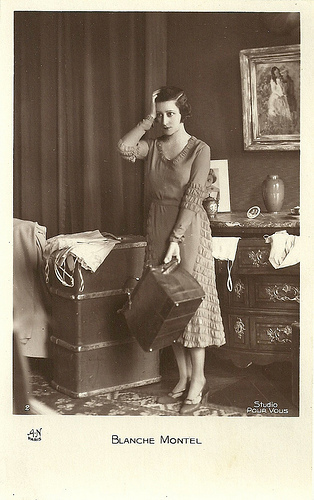
French postcard by A.N., Paris, no. 2. Photo: Studio Pour Vous.
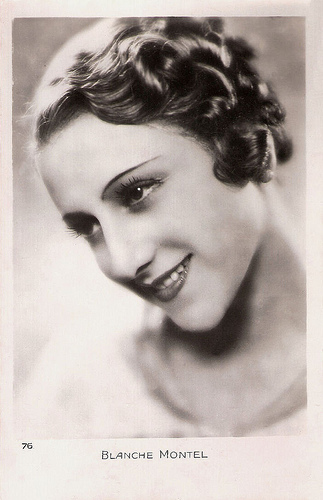
French postcard, no. 75.
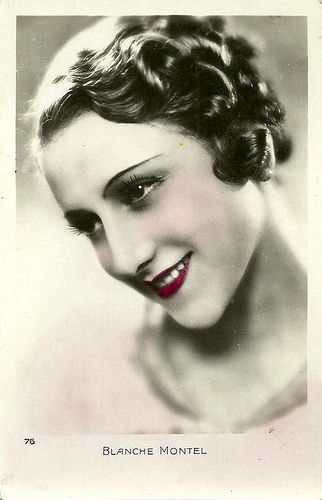
French postcard, no. 76.
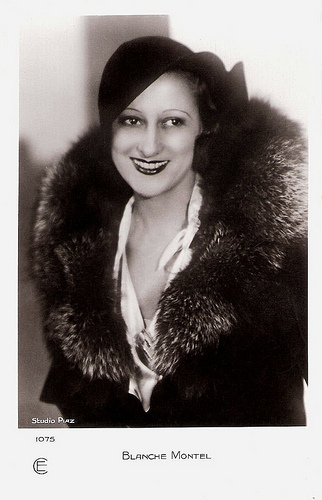
French postcard by Cinémagazine-Édition, Paris, no. 1075. Photo: Studio Piaz.
Sources: Wikipedia (French), Cinememorial, CinéArtistes and .

French postcard. Photo: Film Gaumont.

French postcard by Cinémagazine, no. 11. Photo: Gerschell, Paris.

French postcard by A.N., Paris, no. 269. Photo: G.L. Manuel Frères.
Sensibility, Seductiveness and Freshness
Rose Blanche Jeanne Montel was born in Tours, France in 1902. When she was only 11, she was already engaged by filmmaker Alfred Machin to play a young Dutch girl, Kaatje, in La fille de Delft/A Tragedy in the Clouds (Alfred Machin, 1914). The film was shot at the Belgium Pathé studio of Chateau Karreveld at Molenbeek-Saint-Jean near Brussels.
Montel then worked in scenography until she met Gaumont film director Louis Feuillade, who was impressed by her sensibility, her seductiveness and her freshness. He directed her in various short films but also in long running serials like Barrabas (1919) with Édouard Mathé , Les deux gamines/The Two Girls (1921), and L'orpheline/The orphan (1921), often starring Sandra Milovanoff.
From the early 1920s on, Montel had leading parts in La fille des chiffoniers/The Girl of the Dust Bin (Henri Desfontaines, 1922), Son altesse/Her Higness (Henri Desfontaines, 1923), and Une vieille marquise très riche/An old very rich marchioness (Emilien Champetier, 1923).
It was followed by L'éveilleur d'instincts/The awakening of instincts(Emilien Champetier, 1925) with Armand Bernard , La vocation d'André Carel/The Vocation of André Carel (Jean Choux, 1925) with Michel Simon , Le roi de la pédale/King of the pedal (Maurice Champreux, 1925), and her last silent film La ronde infernale/The infernal round (Luitz-Morat, 1928) starring Jean Angelo .
Montel's first sound film was L'Arlésienne (Jacques de Baroncelli, 1930) and she remained quite active in the early 1930s in films such as the comedy Flagrant délit/Flagrante delicto (Hanns Schwarz, George Tréville, 1931), Clair de lune/Moonlight (Henri Diamant-Berger, 1932) with Henri Garat , and the drama L'enfant du miracle/The Miracle Child (D.B. Maurice, 1932).
Then followed parts in Miquette et sa mère/Miquette and Her Mother (Diamant-Berger, 1933) with Montel as Miquette, Les bleus du ciel/The Blue Ones of the Sky (Henri Decoin, 1933) with Albert Préjean, and La maison du mystère/The house of the mystery (Gaston Roudès, 1933).
In Les trois mousquetaires/The Three Musketeers (Henri Diamant-Berger, 1933, she played Constance opposite Aimé Simon-Girard as D'Artganan. Other films were L'aventurier/The Adventurer (Marcel L'Herbier, 1934) starring Victor Francen , and Durand bijoutier/Durand Jeweller (Jean Stelli, 1938). In addition to these films Montel played smaller roles in various French films of the 1920s and 1930s. In those two decades she was also an acclaimed stage actress.

Belgian postcard by Nels / Ern. Thill, Bruxelles / Alliance Cinematographiques Européenne. Photo: Ufa. Publicity still for Flagrant Délit (Hanns Schwarz, Georges Tréville, 1931). Flagrant Délit was an alternate-language version of Einbrecher/Burglars (Hanns Schwarz, 1930) with Lilian Harvey and Willy Fritsch .

French postcard by Nels / Alliance Cinématographiques Européenne. Photo: Ufa. Publicity still for Flagrant Délit (Hanns Schwarz, Georges Tréville, 1931).

French postcard by Nels / Alliance Cinématographiques Européenne. Photo: Ufa. Publicity still with Blanche Montel and Henri Garat in Flagrant Délit (Hanns Schwarz, Georges Tréville, 1931).

French postcard by Nels / Alliance Cinématographiques Européenne. Photo: Ufa. Publicity still with Blanche Montel and Henri Garat in Flagrant Délit (Hanns Schwarz, Georges Tréville, 1931).
The Beautiful Nivernaise
A highlight among her silent films was La belle Nivernaise/The Beauty from Nivernais (Jean Epstein, 1924).I
n the documentary series Cinema Europe: The Other Hollywood (1995), Kevin Brownlow and David Gill interviewed Blanche Montel. She tells ironically how surprised she was, that after she was asked to play the female lead in La belle Nivernaise, she found out that the Nivernaise was not a beautiful young girl but a very old and ugly boat.
This quite naturalist film on life aboard a barge precedes Jean Vigo's better known L' Atalante.
Between 1927 and 1934 Montel was married to film director Henri Decoin, but she did not play in many of his films.
In the early 1930s she played more often in films by Henri Diamant-Berger. Montel and Decoin had one son, Jacques (1928-1998). After she had divorced Henri Decoin she had an affair with Jean-Pierre Aumont , until 1940 when Aumont fled to the United States.
Blanche Montel's last performance was that of Madame Brown in a film by her ex-husband, L' Homme de Londres/The London Man (Henri Decoin, 1943), a Georges Simenon adaptation. In 1946 she started a new career as an impresario for artists.
After her son Jacques died in 1998, Blanche Montel soon also passed away in 1999 in Luzarches, at the high age of 95.

French postcard by A.N., Paris, in the series Les Vedettes de Cinéma, no. 56.

French postcard by A.N., Paris, no. 2. Photo: Studio Pour Vous.

French postcard, no. 75.

French postcard, no. 76.

French postcard by Cinémagazine-Édition, Paris, no. 1075. Photo: Studio Piaz.
Sources: Wikipedia (French), Cinememorial, CinéArtistes and .
Published on September 05, 2017 22:00
Paul van Yperen's Blog
- Paul van Yperen's profile
- 13 followers
Paul van Yperen isn't a Goodreads Author
(yet),
but they
do have a blog,
so here are some recent posts imported from
their feed.



